-
Posts
1,999 -
Joined
-
Last visited
Content Type
Profiles
Forums
Store
Help Articles
Posts posted by Peter Green
-
-
March 25 – Part 3 – Back on the programme
"Is this chicken, what I have, or is this fish? I know it's tuna, but it says 'Chicken by the Sea.'" Jessica Simpson from MTV’s Newlyweds.
Scud and I putzed about, getting our shots in while trying not to be overrun by massed squadrons of forklifts. And then I noticed some activity over to our left, across the alleyway which constituted a deathtrap of speeding hardware, through what appeared to be a hanger door.
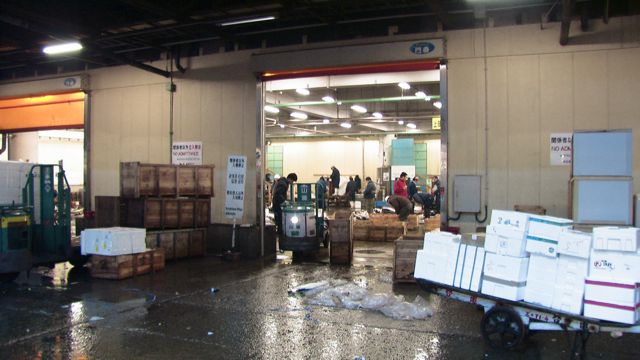
This is where they keep the big boys.
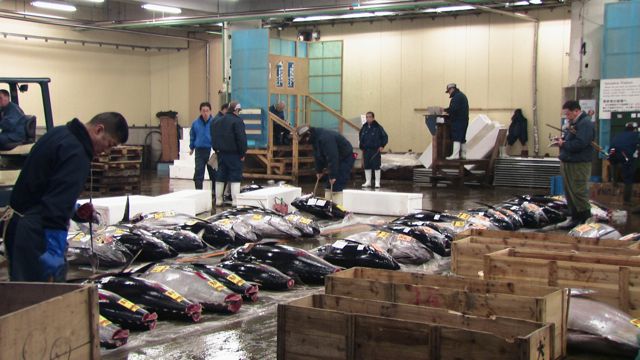
Charlie! What have they done to you Charlie! They’ve mutilated you and put you out on display!

Okay, I said I wouldn’t go grim again.
Let’s consider the history of mascots in the tuna business. And songs! If there’s anything guaranteed to get me universally reviled, it’ll be planting the seed of those catchy theme songs in your head again.
Okay, first Charlie the Tuna.
Born in 1962, there’s a lot of controversy surrounding Charlie. The accepted version is hat he’s the product of actor-songwriter Henry Nemo, who was buddies with Tom Rogers, who in turn worked for the Leo Burnett Agency, who in turn had the advertising contract for StarKist.
However, another claim, but actress Maila Numi (Best known as Vampira, and part of the cast of the classic Plan 9 From Outer Space……if you haven’t seen Ed Woods, do it now) held that Charlie was actually the offspring of James Dean, who had sketched him before his death (James’ death, that is).
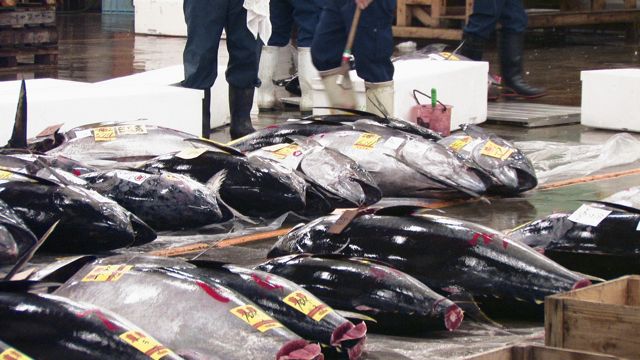
And now look at poor Charlie. Beret gone, gutted and amputated on the auction floor, he was still a tuna with good taste.
Tuna, when you consider them, are a marvelous fish. They’re fast. Really fast. I’ve seen them whipping by underwater in the Red Sea by Hurghada. And they come in a great variety of sizes, form the salmon sized ones we’d catch back in Egypt (and eat grilled with a drizzle of oil), to the bigger fish that we see on the market floor here, up to the giants of the sea that’ll fetch the big big bucks.
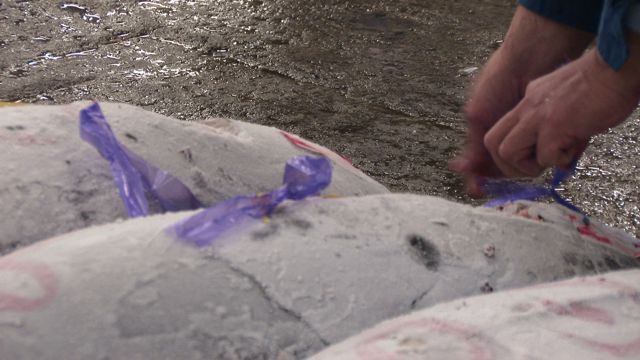
Sorry, Charlie.
Now, let’s not forget the Chicken of the Sea Mermaid. “Ask any mermaid you happen to see, what’s the best tuna? Chicken of the sea.”
Try as we could Scud and I couldn’t turn up the mermaid. Maybe she’s out there in one of the back alleys, her pearls and wand long since pawned for booze money, scavenging scraps from the rubbish bins….?
Okay, okay, I’ll get off of the grizzly theme!
Where was I?
Oh, yes, the auction.
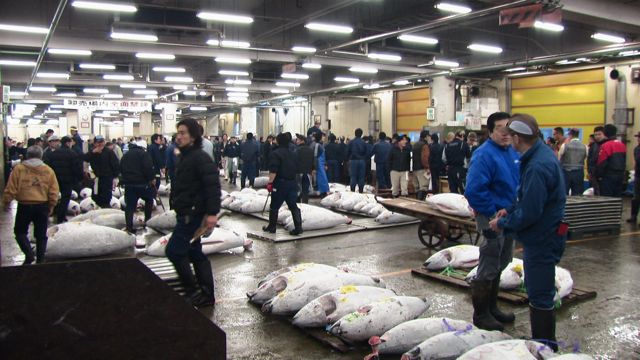
The majority of the fish up for grabs were frozen. In part for shipping, but also in part for ensuring the death of the host of parasites that thrive in fish. Yoonhi was mentioning this, that most wild fish needs to be frozen (if feasible) for quite some time to ensure that the critters along for the ride are killed off. Salmon, typically, can often be frozen for months before it’s used. This works well enough with oily fish like salmon and tuna, as ice crystallization doesn’t damage the meat too much (but does pierce and kill the parasites).
For a real appetizing read, check out this bit of alien happiness from the FDA.

And if you think fish doesn’t have parasites, Yoonhi has some wonderful stories of her mother’s, watching the fish fillets go by on the conveyor belts under harsh industrial lighting. You gotta love harsh lighting, it shows every little, squirmy thing off to its best.

You guys have read all this before. The buyers marking their fish, the crowds gathered round the auctioneers, each buyer with his tag on his cap.
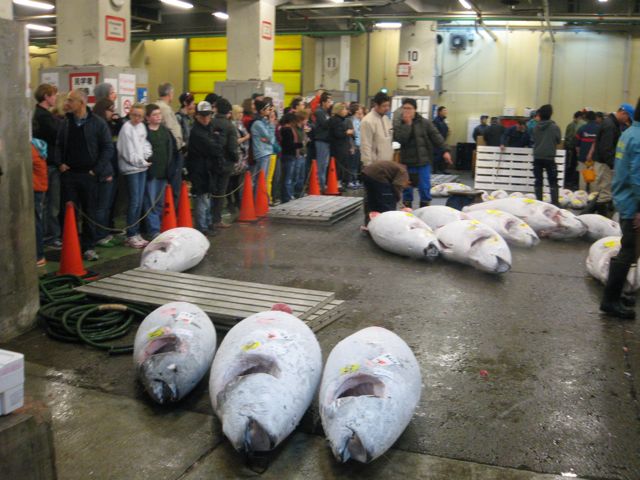
What was different for me was seeing the tourists herded off behind the ropes so that they didn’t interfere with business too much. This really has become the de rigeur tour of a Tokyo visit. I hadn’t seen this many foreigners outside of Roppongi before.
Most of them seem to have come in groups, with one tour guide keeping them more or less contained, while others, like Scud and I, had drifted in in ones and twos.
But, you can only spend so much time watching people buy fish. And watching people watch people buy fish. We took our shots, and headed on.
Next: More fish
And, if you think I forgot about Bumblee Tuna, check out this
(which gets us back on the anime/manga topic). -
Those shellfish look so good.
Was the smell in there overpowering at all?
Strangely, there was almost no smell.
It was oddly clean, and sterile (almost).
If there's anything I associate with it, it's that non-smell of styrofoam.
More soon.
-
Right now, for Tokyo, I'd be leaning towards Ryugin.
Also, if you're around Asakusa, it's not far from there to Ryogoku, and you could do Popeye. This assumes you like beer. Hit them up for happy hour, and the savings on food will balance the cost of the beer.
-
There.
My apologies if anyone found it on the grim side, but I've been on a steady diet of Lone Wolf and Cub, Zatoichi, and Takashi Miike flicks.
So that just needed out.
I'll return to the standard $110 morning tour of the market now (after I get some sleep).
-
March 25 – Part 2 – Fade to White
Early mornings in big cities give you a different perspective on things. Consider Bangkok. There’s something magical about the way the skytrain lights come on with morning just breaking through the smog, the last of the drunk tourists vomiting in the gutter, the katoey rifling their pockets, and the first few Isaan workers shambling stoically to their posts.
And in Tokyo, with the first train of the morning, sleep is still like some eldritch spirit, it’s fingers distributed through the warren of underground passages, clutching the Japanese in a grip of somnolence.
Our train already had people on board, and almost all were sleeping, piled in slantwise drifts against the rails; heads thrown back, or else nodding forward, white masks pulled up and covering their features. Faces wiped clean of emotion, of personality. This was a sleep with dreams.
One young lady slept (we think) across from us, her hair fallen forward, a hood pulled up, just a black hole where her face should have been.
It was almost like you could feel the torpor stretching out into the dark that we were hurtling into.
Finally we fell upon Tsukijishijo. Around us sleep fell away from most of the bodies and as a group they arose and filed out onto the platform. No smiles. No emotion.
This placed us at the foot of the Asahi Shimbun offices, and only two blocks from the market. We strode off, into the dark.

There’s a grim efficiency about the market. I saw no one laugh, or even smile at this time. There was a swarm of traffic as the trucks, carts, forklifts, and handcarts glided about each other, oblivious to the pale ghosts of tourists that tried to worm their way through this giant carcass of a market.
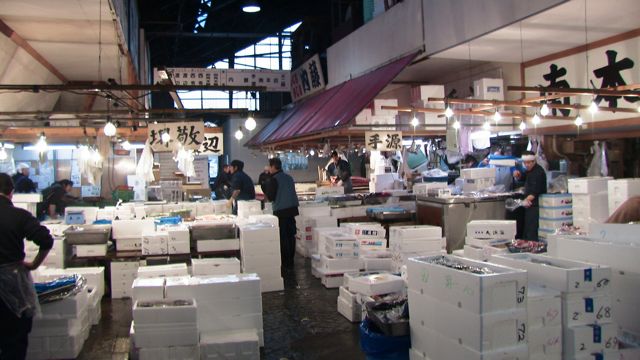
White. Everywhere you looked was white styrofoam. Coincidentally the colour of death.
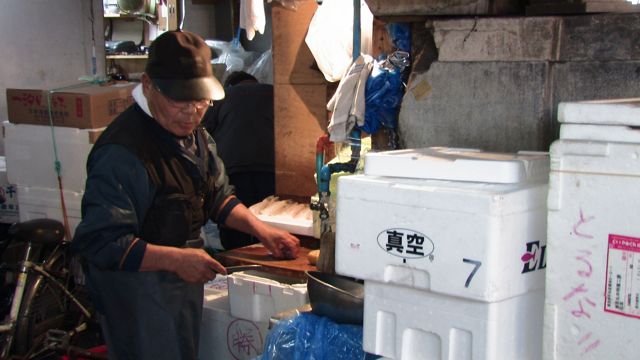
There was a seriousness here, a business like attitude, a professionalism. This lacks some of the aesthetic charm of Garak Sijang (although there’s a certain amount of white styrofoam there, too), it lacks the feeling of community, and enjoyment.
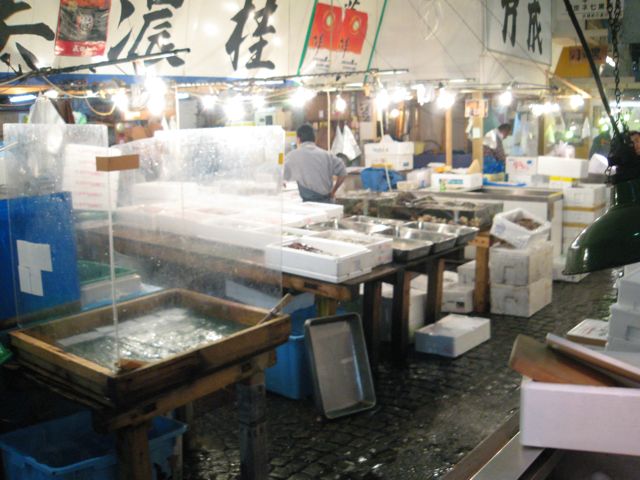
Perhaps this was in part due to the hour of our arrival. We were hardly here at peak time, rather in the twilight of the sales surge, when the meat is either spoken for, or being packed away for another day.

For some it was too late for a reprieve. They were dead and destined for some use, if not the table.
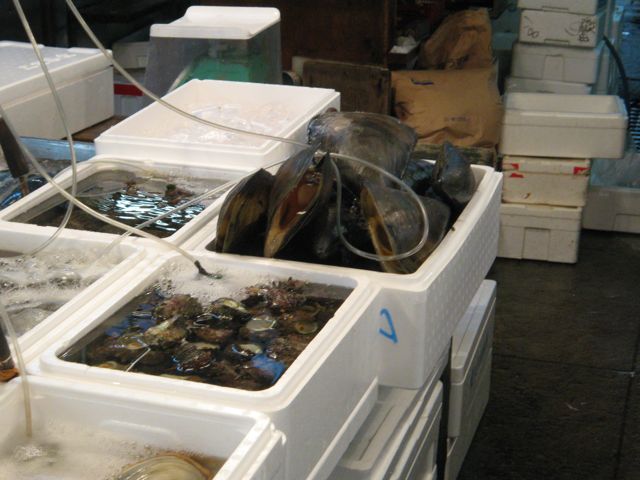
Like patients on life support, or perhaps more like bodies kept alive for their organs, the water lines snake about to the shellfish. These are still with us, to wait their fate another day.
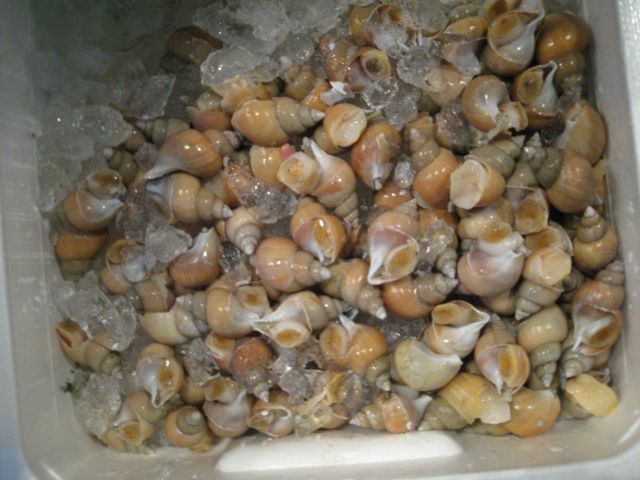
But consider this huddled mass, who linger on the brink of death in their frozen sleep.

And sleek squid, their eyes frozen in the surprise of death.
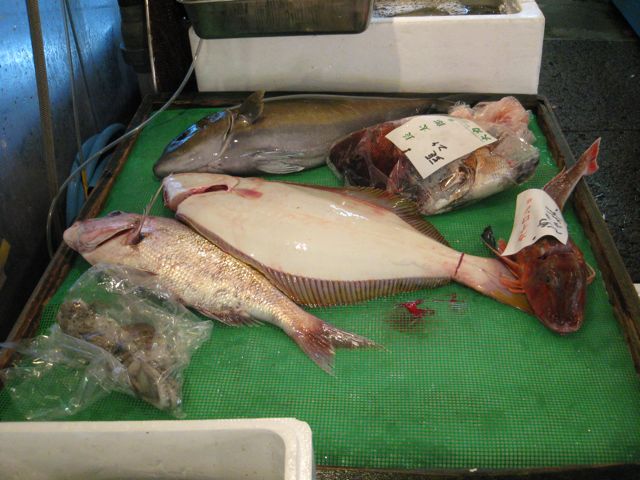
In Bangkok last WGF, Karl Kanetani (spouse of Katrina Kanetani
from the Pier, and chef at Este, both in Sydney) talked of how the Pier’s fishers had adopted the iki jimi kill. Traditionally, this is a spike to the top of the head, but can also bethrough the gill and up to the brain. In either case the intent is to kill extremely quickly, and so not stress the fish. The rainbow pattern on a tuna can indicate a painful end. But Karl talked of a new method, Hitchkokian in detail, that sees a steel wire introduced into the spine of the still-live fish, reducing it to a state of torpor – but not death. I imagine that nightmare time, when you’re awake, but you can’t bring yourself to move. The Thai describe this as the phii aam, which sits upon your chest while you sleep, and slowly crushes you.
I can see that thread, descending into the flesh, and then touching the nervous system with a cold kiss.
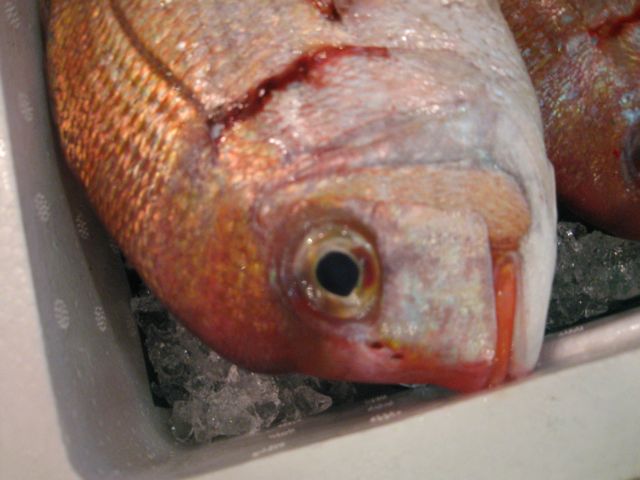
And all you can do is stare.
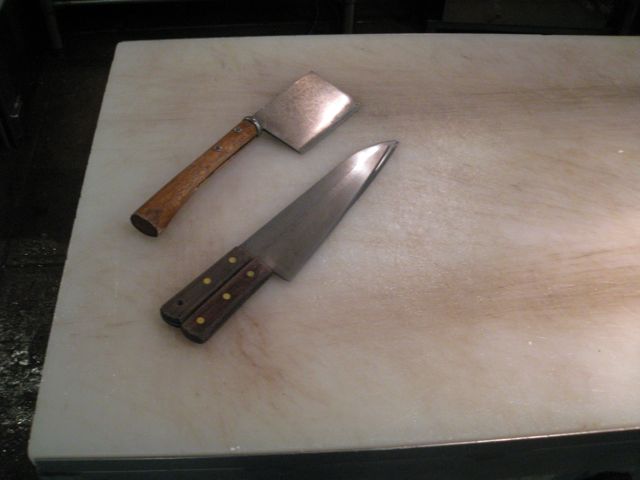
And when death comes, it may be a simple cut, a release, with a blade of elegant sharpness. An operation, rather than an execution.

An image expressed in the clean sheen of steel, but finalized in scarlet.
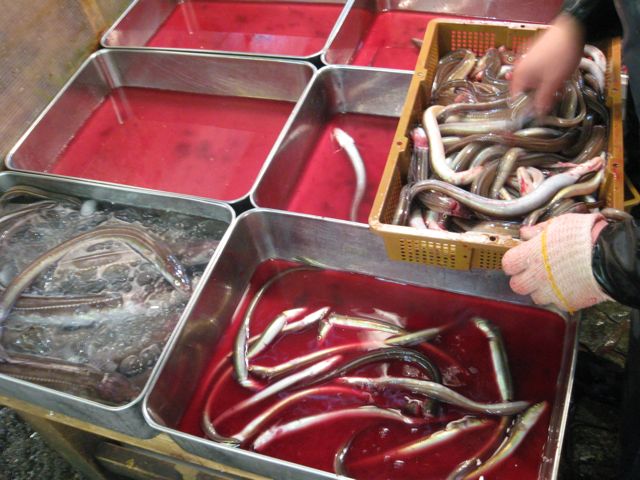
The slow writhing in your own blood.

Disassociate the dead from their corpses, and they’re beautiful with the richness of their colour, from deep reds to white-mottled pink, like a selection of wines.
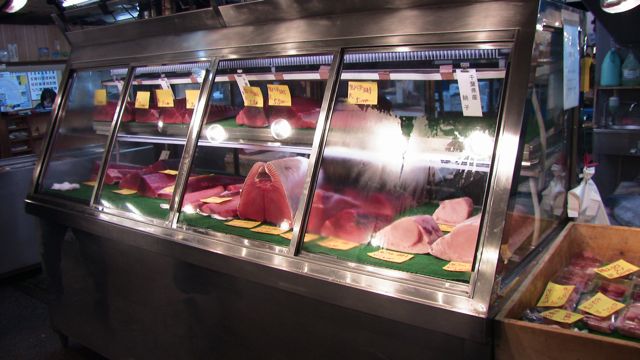
And, at some point, the relationship between body and meat is severed, and you can marvel at the flesh as a thing, as an object, and forget life was a part of it.
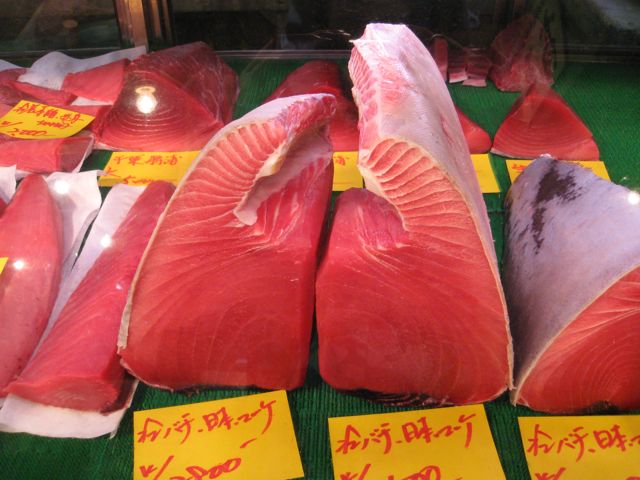
Next: I lighten up
-
Before I put up the next post, let me just say that I swear I have not joined PETA or any other cult.
It's just something that wanted out.
-
March 25 – It Smells Like Fish…
It was 4:30 a.m. and we had to be moving.
You knew I was going to do this. For good or bad I had to go to the market. I had to do the pilgrimage.
Honestly, I’d debated this beforehand. Early morning tour of dead sea critters vs lying in bed and then drinking coffee, watching cartoons, and writing on the computer.
What had turned the trick in my head was an article in the Cathay in-flight (March 2008 “Tsukiji – Slipping Away”) that described the market, and then went on to detail the city’s plans to do away with the 23 hectare site in Chuo Ward and move everything to a newe spot on Toyosu Wharf, increasing the market to 38 hectares. That sounds pretty good, in terms of getting people more room to work, but consider that the government is going to be using part of that space for shops, museums, cooking schools, and a theme park.
Okay, I can deal with cooking schools, but do you really need a theme park at a market? “Honey, I’m just popping out for some tuna, squid, and maybe a ride on the Monster Mouse.”
Otherwise the piece was as you’d expect. “It’s nice to have something new, but we’re attached to the old lady” sort of stuff. About what you’d expect for a market that’s been functioning for around 70 years.
So, yeah, if plans go through Tsukiji will be a thing of the past by 2012.
At least that gave me something to use in convincing Scud he had to go. That and brute force.
Pain usually works.
Next.........something different
-
March 24 – I yam what I yam
The afternoon was a lazy thing. I was tied down with a three o’clock appointment, so I used the hours to catch up on my writing and take some sake. The Boy ditched me and headed back to Akihabara/Akibahara….the place with all the comics and DVDs. He was happy, I was happy.
My appointment took me up to Iidabashi, where my directions had me going to the Japan-China Friendship Center. I figured, given two weeks of eating and drinking, I should try and do something physical at least once.
Don’t you love it when people volunteer you for things? One of my very good friends, a devoted tia qi practitioner, had been here a month before, and had talked about her Canadian friend who would be coming to Tokyo. Somehow this turned into an obligation on my part to be here…..well, actuallly I quite enjoyed it, and it’s a chance to meet people outside of the food and beverage side of things. People like one older fellow in training who I found to be 92 years old. Heck, he’s spryer than I am.
I returned home from this with both a thirst and a hunger. Scud had already come back with his latest treasures, and he, too, was interested in getting something substantial.
We’d agreed. This evening we were going to go somewhere wonderful.
We were going to Popeye.
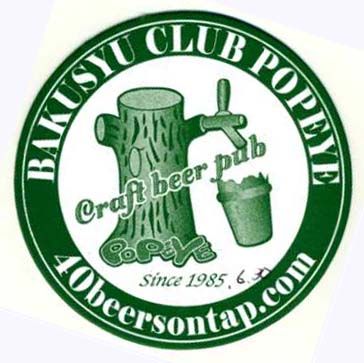
Or, to be more exact, Bakusyu Club Popeye
In the little prep I did for this trip, one thing had become clear. I needed to get to Popeye. Beer Club Popeye. If you want to get as much good beer as you can in one sitting, this is the place to be in Japan. Forty beers on tap. Those are words to get any engineer excited.
Microbrewing has had a rough time of it in Japan. As Hiroyuki has pointed out, it’s actually illegal to home brew in Japan (at least above the 1% alcohol level, and then what’s the point?). Breweries, until 1994, were not allowed to produce in volumes less than 2 million litres a year. Then, at that magic moment in time, the legislation was relaxed to allow smaller batches of 60,000 litres to qualify for licensing.
Note that this was a good 8 years earlier than Korea, which only just liberalized their brewing laws in 2002, allowing some small-scale competition into the market.
You’d think that would be the end of the story, but the very same Happoshu we’ve been discussing favourably earlier in this thread are in part to blame for the troubles of the small breweries
That is to say, cost. Craft brewing is never a cheap alternative to the industrial players, and it gets even worse when they’re coming up with innovative ways to deliver a refreshing beverage for less money. With the price point for microbrews in the 800 to 1000 yen plus range for a pint, you’ve got your work cut out for you competing in the open market.
Of course, if you compare that price against what’ll it cost you by the hour in some of the places in Roppongi…..
I wonder if there’s a vending machine out there somewhere in Tokyo dispensing a good small brew bitter?
But, back to Popeye.
I’ll warn you now, this isn’t the only trip to Popeye, so I’ll write some of it now, and save other bits for when I return in a couple of days.
But let’s set the scene.
We came down at Ryogoku on the Oedo line. Convenient for us to catch leaving Roppongi, but it meant a bit more of a walk for us in the streets of Ryogoku. I didn’t mind. As soon as we passed under the JR tracks and saw our first giant fish on display, I started to like this neighborhood.
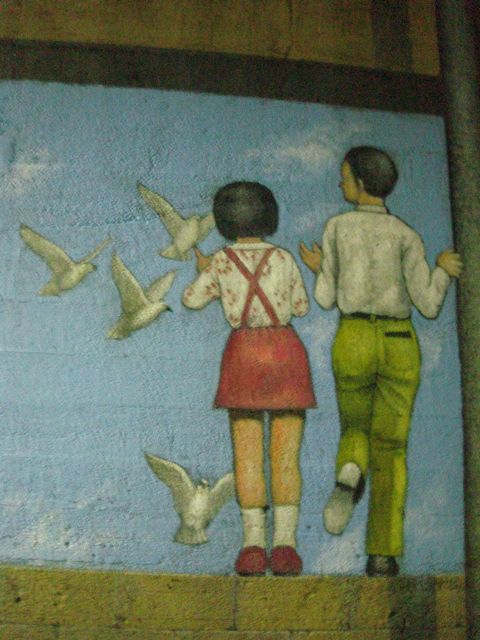
Walking down along the rail embankment, I almost felt that I was in a cross between a Miyazaki movie and the backstreets of Seoul.
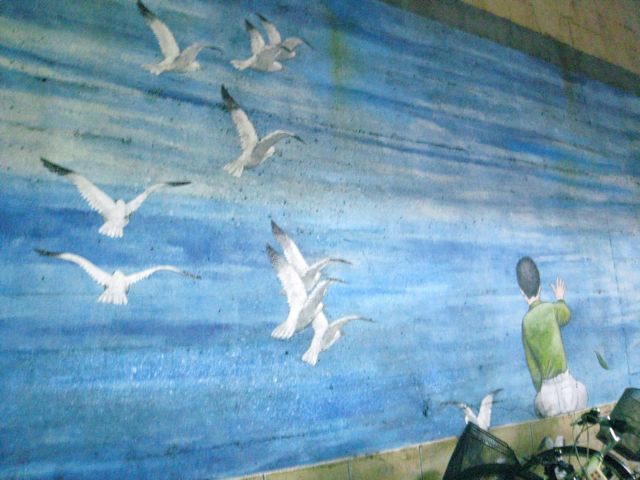
The embankment wall was adorned with murals of days gone by, the sort of turn of the century look of balloons with passengers, seaside viewings, and people with hats with ribbons.
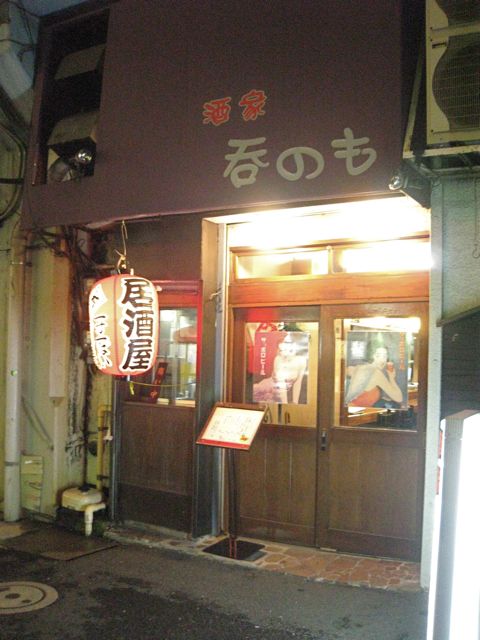
And fronting that (and built in under the tracks) were all sorts of neat looking eateries.
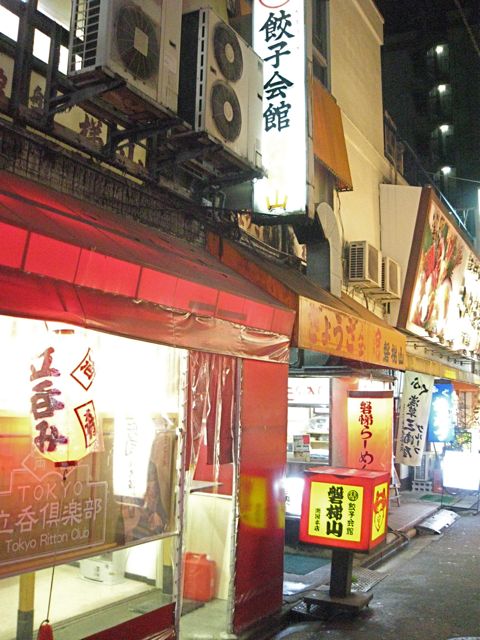
There was one yakitori place with a grill streetside that looked particularly good.
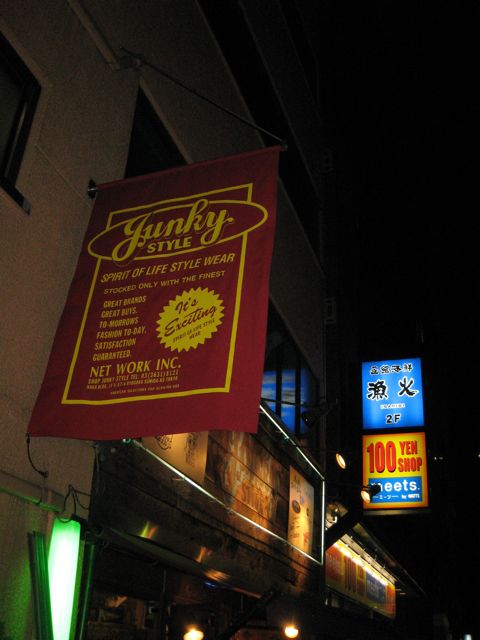
And then there were shops with used clothing

And lots of arcades and pachinko parlours.
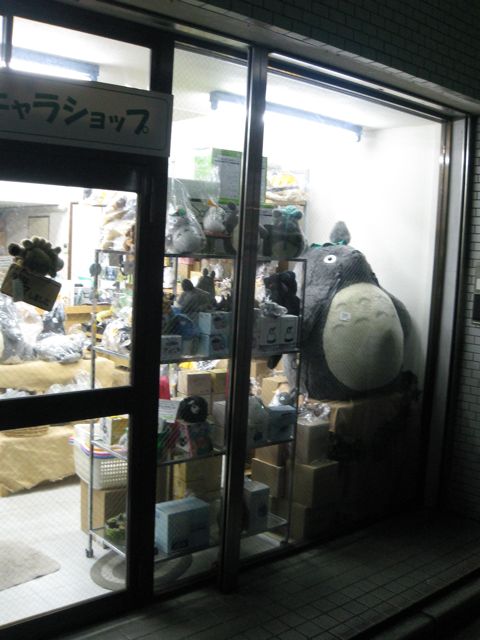
I even found a Totoro shop.
And lots of bars.
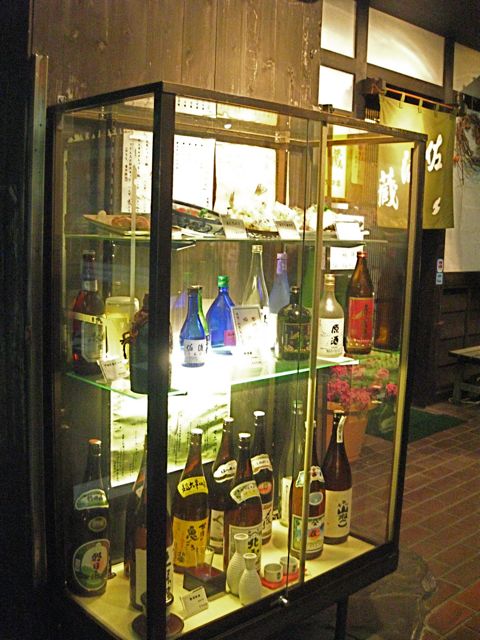
Like I say, it reminded me of happy times in Seoul.
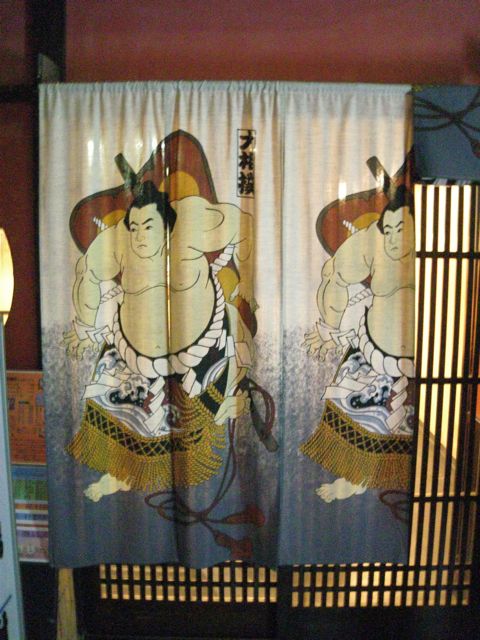
Ryogoku is also sumo territory, with lots of chanko places around, and the odd bit of statuary. (Is it good luck to rub their tummy?)
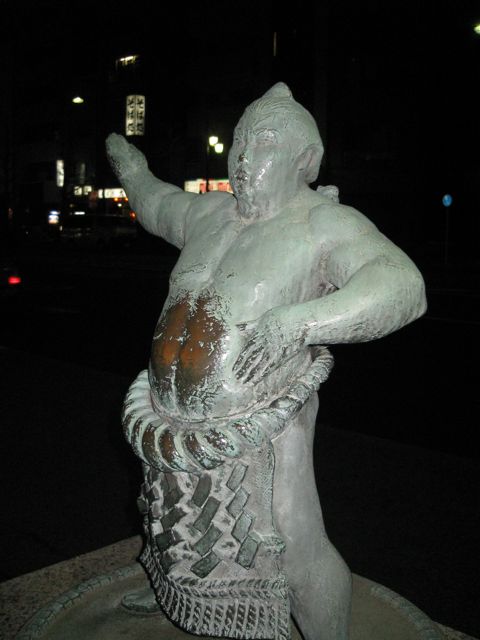
None of which helped us in finding Popeye.
The directions looked easy enough, but I was obviously missing a side street somewhere.
Item number 842 to like about Japan. If you approach any nice, older, respectable female Japanese lady in, say, a florist shop, and ask her for “biru klubu Popeye” there’s a very good chance she’ll know it, and will show you the way there with great enthusiasm.
You’ve gotta love this place.
Once we were on the right street, it was easy, and we just looked for the fairly modern place that was packed out with people.
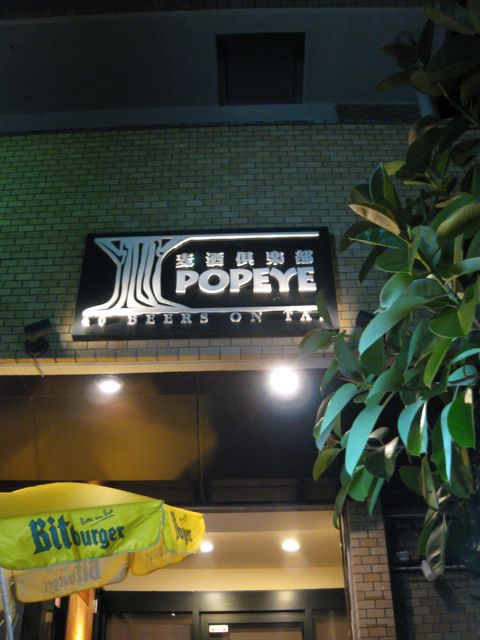
The décor, as you would expect, is centered around beer. It’s a little cramped, but that’s only because they’ve had the good sense to optimize seating (you don’t seem to stand around much in Japanese bars, probably as you’re expected to eat). Still, with all of these tables, Scud and I did need to wait by the door for a few minutes for a table to open. Do you know what sort of torture it is to be waiting, thirsty, by a beer fridge?
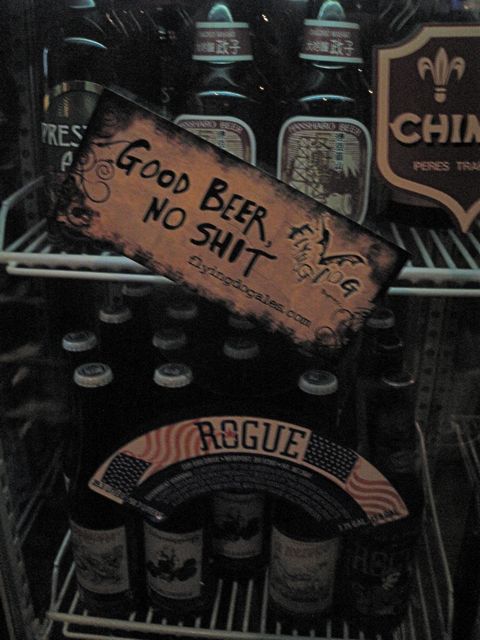
The suffering I go through in the name of research.
Soon enough we slid around the chairs to take up position in a corner spot. I wedged in, and sighed with relief that I hadn’t upset any drinks or tables en route. We hadn’t spotted Godzilla yet, but I had a pretty good idea of what he felt like (I’d need more garlic to get the breath right, though).
First excellent bit of news! In the sheef of paper they give you, there’re English menus. And, while I didn’t see anybody obviously foreign, I did pick up Canadian and American accents from a number of the tables around me.
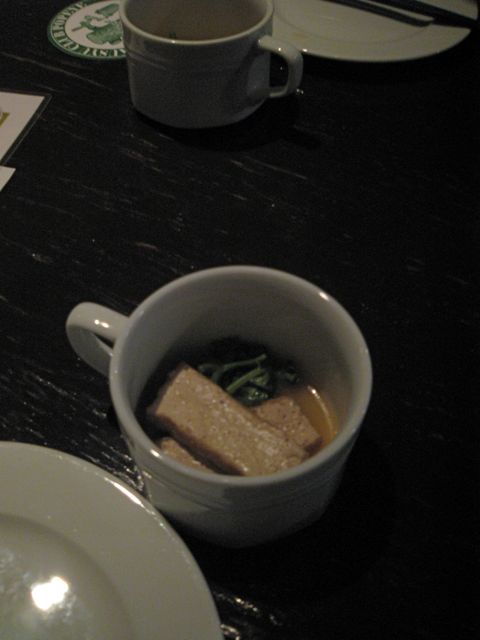
Second good news! Before you’ve even ordered anything, they set a nice little bit of tofu down for you.
Third good news! The staff were fluent enough that we could work out a few important items. The first of which was that I needed a sampler.
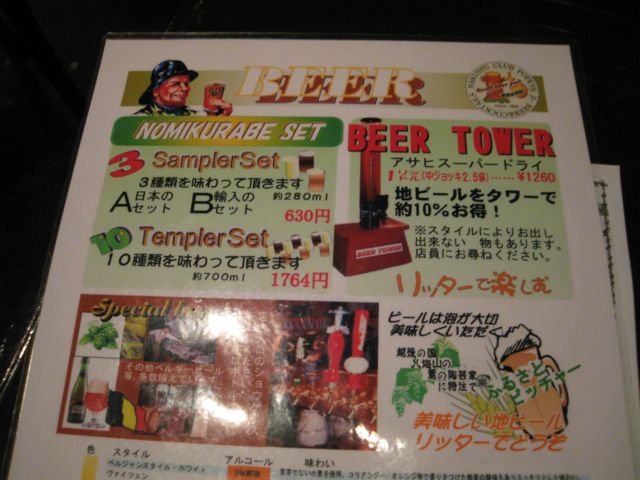
Fourth good news! They have towers.
I was very excited.
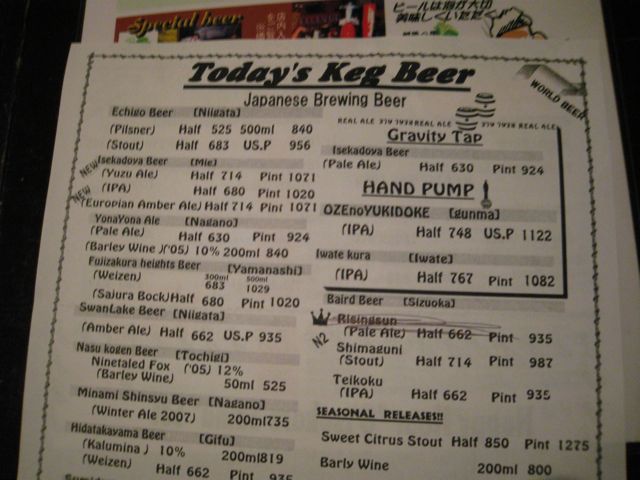
I’d leapt into the decision to do a sampler, but I still wanted to look at the full listing.
Coincidence. It keeps on cropping up.
The Boy had chosen today to wear his new purchase, the Nine Tail Fox t-shirt (Naruto) that he’d bought in Akihabara. I figured, no one is going to begrudge us our attire in a beer hall.
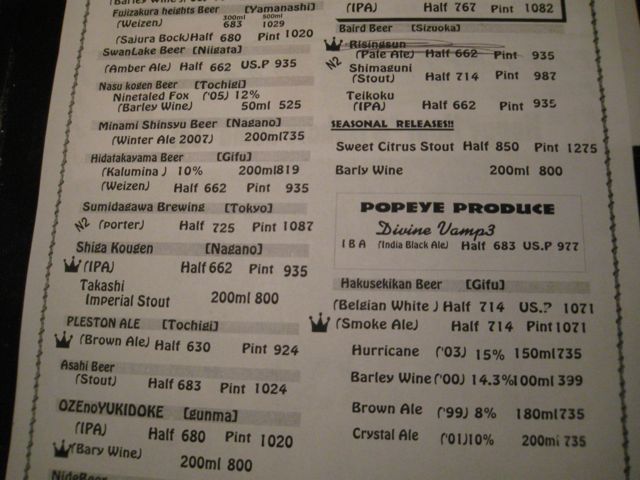
What should we see on the menu but Nasu Kogen Beer’s Ninetailed Fox Barley Wine, a 2005 product weighing in at 12% alcohol, served in a 50 ml cup.
In a shot I was ordering this for the boy. But it wasn’t meant to be. The waitress came back, very sorry, but the Ninetail was finished for the night.
Probably for the best. Some spirits just don’t mix well.
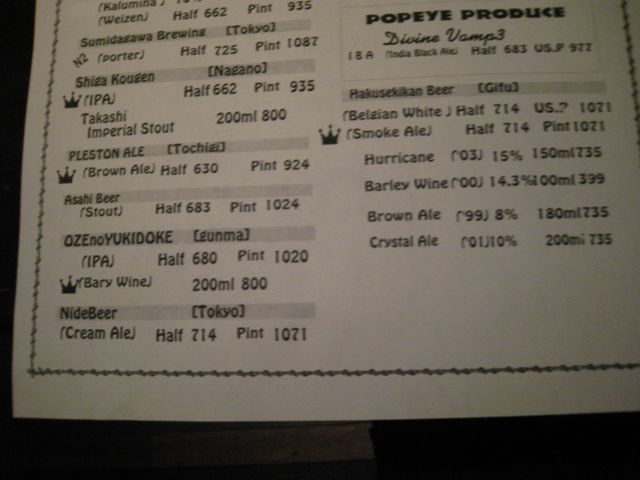
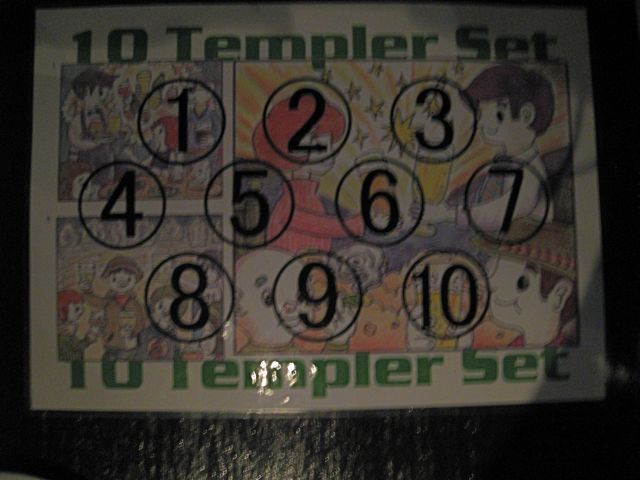
My taster came, and I was kind enough to give up some of this for Scud’s education.

Our first beer, to the front and right with the fuzzy head, was from Gifu’s Hidatakayama. This was a Weizen. The body was very full, and it was on the sweet side for me. Scud approved of this, and enjoyed the taste in his mouth, while I wasn’t too keen on the overall effect.
Next was another product from Gifu, this time from Hakusekikan – a Belgian White. Again, on the sweet side, with a bit of tang in there, and a reasonable presence of hops.
Number three was from Yamanashi’s Fujizakura Heights; their Sajura Bock. Dark, carrying a good head at first, and also on the sweet side. Again, the split went down with Scud liking it (up there with the Weizen) and myself feeling that there was something missing.

At this point the first of our food orders showed up. “Bitter sausage (the hop is in)”, served with a little bit of sauerkraut, mustard, and some ketsup. This was very, very good. A nice texture to the sausage, without getting too gristly. The flavour did carry the hops well, and I immediately considered ordering another.
But now we had beer numbr four to deal with. From Gunma, this was a product of OzenoYukidoke. The first IPA in the tasting. This wasn’t at all bad, nicely hopped, and with the bitterness I’d been looking for. (This is the one in the middle at the back by Scud’s elbow).
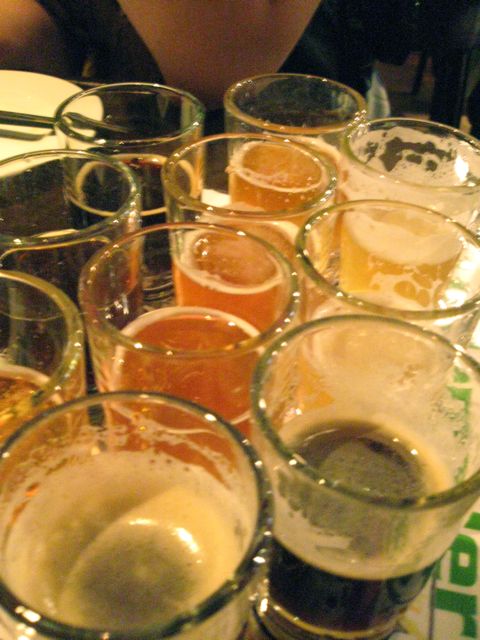
Then it was Mie’s turn, with Isekadoya putting forward two beers. The firsr of these was their Yuzu Ale, a fruity number with a sweetness that came through in the palate and in the nose.
The second Isekadoya (beer number 6) was an IPA again, but this one not as well accented with hops. A kinder, gentler bitter that went well with the Boy, but I was casting my eyes back on the OzenoYukidoke.

Scud had ordered the minimutton steak. This came out quite rare, almost blue. As the plate was sizzling, it must’ve been almost raw when it went on. A nice bit of meat, helped out by having been wrapped in bacon in much the same way as they did with Elvis’ brain. This flavour came out in a great gravy in the bottom of the sizzling plan that we sopped up with the potatos.
Which lined us up for number 7, Popeye’s own Divine Vamp3, an IBA (India Black Ale). I found it very smooth, almost but not quite velvety. A good flavour, with almost metallic notes. Scud, for his part (heathen) described it as reminiscent of dental amalgam.
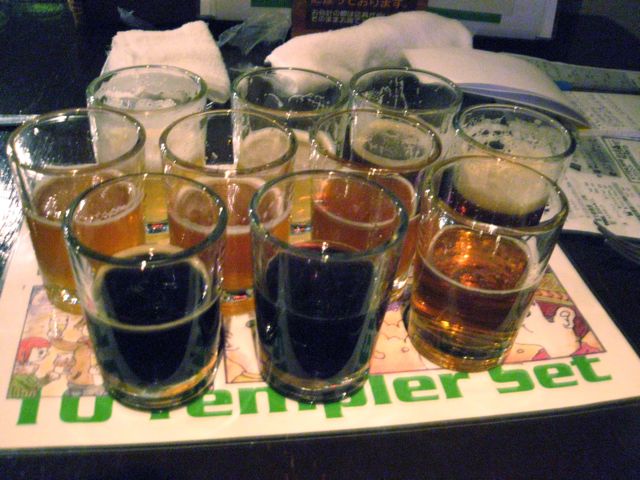
Then there was a sweet citrus stout (front left here). This was under the heading of “seasonal releases!!”, so I can’t really tell you who the brewer was. I found it on the sweet side, and too thin for me to take it seriously as a stout. It wasn’t a bad flavour, though, and, putting aside the stoutness issue, I could drink this.
After this we returned to Gifu and Hakusekikan for the finish. Number 9 was a barley wine, a 2000 vintage with a 14.3% alcohol rating. This was dark, and tangy in the throat. Good hops, and a pleasant thing to sip slowly. Surprisingly, Scud liked this, too. At least he was smiling a lot.
And our finish was Hakusekikan’s Crystal Ale, another barley wine at 10%, amber in colour and sweeter, striking much more as a Belgian approach.
And, speaking of Belgians, I observed a nearby table ordering in some Belgians, all of which came with the appropriate glasses.

As I thought about the ten we’d just walked through, my favourite would be the fourth, the IPA from OzenoYukidoke in Gunma. Scud chose the Weizen we started with as his favourite.
But, as they say, beer is in the belly of the beholder, or sometthing like that. Popeye’s was crowded and there were more people coming in regularly. Having finished our ten tasters and a couple of plates of food, it seemed improper for us to be taking up needed space.
So we ordered more beer.
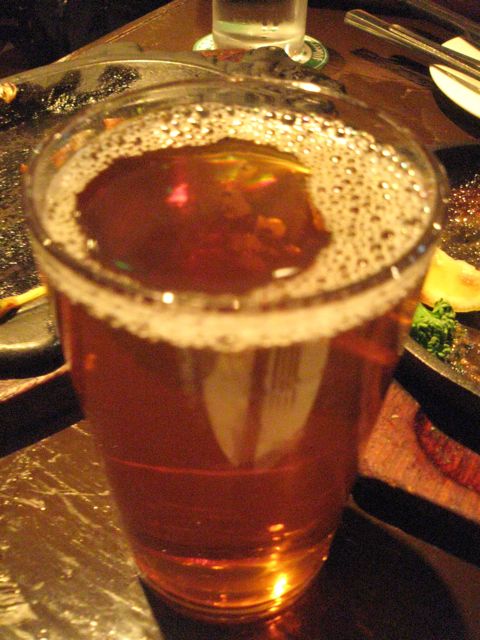
I ordered a half of the Isekadoya Pale Ale. This was a gravity tap, which is a fine thing to see in a bar.
My notes are written “That’s a nice one”. This was a very well-balanced ale, pushing the watery side, but without giving up its essential essence of beer-ness.
This called for sausages.
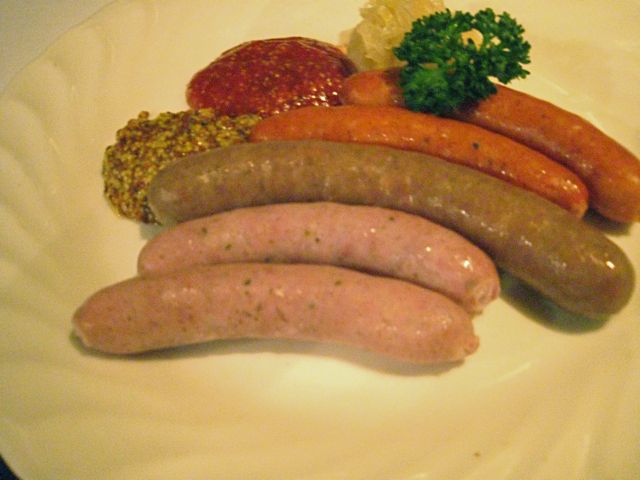
It was the best of times, it was the wurst of times.
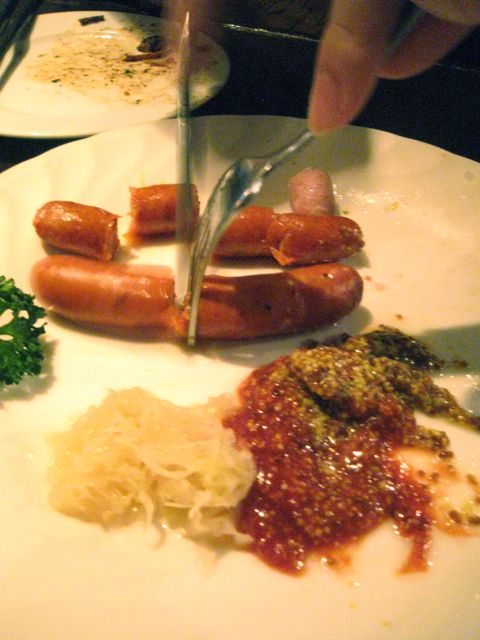
The trio was good, not as outstanding as the hopped sausage earlier, but all had a good texture, were properly cased in intestine, and were properly herbed. I could eat these.

Having enjoyed the Ozenokidoke so much, I had to try their hand pumped IPA. This came out with a creamier head than the regular tap version, and the hops were even more pronounced. I wouldn’t put it up there with Singapore’s Brewerkz’ XIPA, but this was a very drinkable beer.
The menu included a reference to Popeye’s famous snake potatos. I figured, what the heck. “Strings of fresh fries” sounded good. It was fried.

But these weren’t hot. They suffered from having been kept around for awhile as bar snacks. Pity, as they were very similar to what we’d seen last year on the streets of Myongdong in Seoul, and, hot, it’s an excellent way to maximize the surface area for frying.
And remember “frying is good”.
A pair of foreigners came in. Regulars, one would assume, by the cheers that went up from staff and a number of the customers. I’d call them “serious beer drinkers” except that they were smiling too much to be too serious.
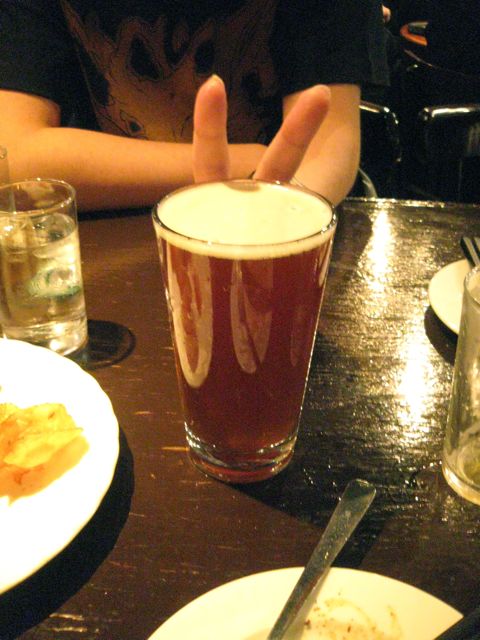
That last hand pull was so good that I decided to stretch my luck and went for a half of the Iwate Kura IPA. Again, an excellent head, and even more hops in this one.
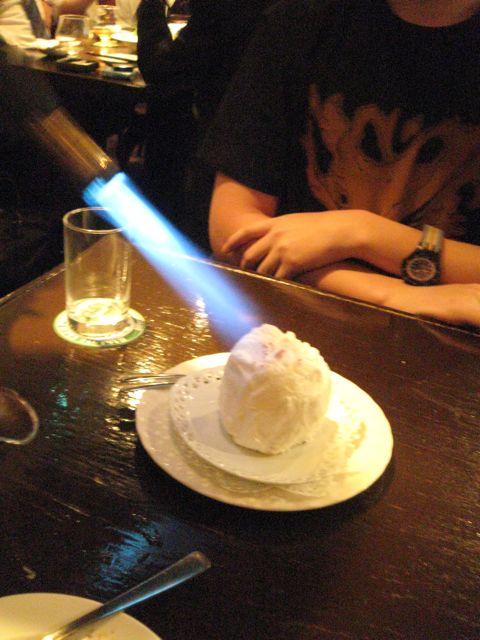
Scud, of course, exercised his right as a new beer drinker to have a baked Alaska.
Why is it that we only find baked Alaska in places with good beer? Here at Popeye, and at the Londoner in Bangkok (but that was years ago. No longer available on Sukhumvit, sad to say).
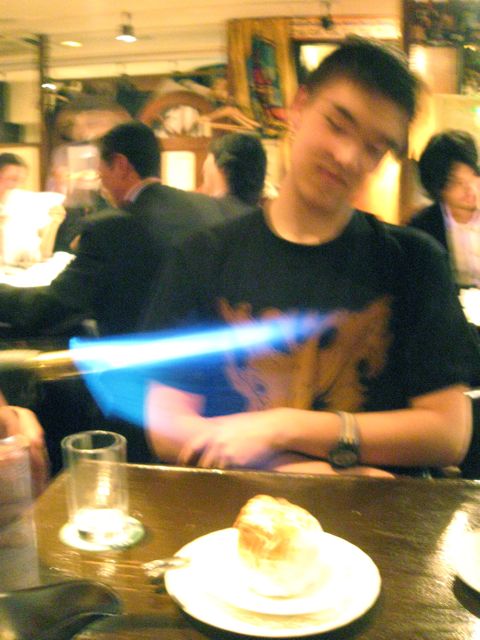
Scud was very happy with this, even when I tried to get the waiter to blowtorch his eyebrows off.

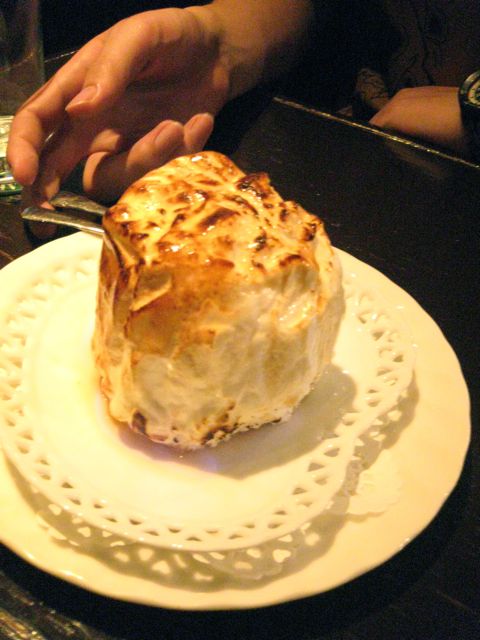
I finished with a foreigner, taking a half of Oregon’s Rogue Breweries Brutal Bitter. It was a name I couldn’t pass up, and the flavour, with a bite that made Scud wince, took me back to the overhopped products of some of Vancouver’s better establishments.
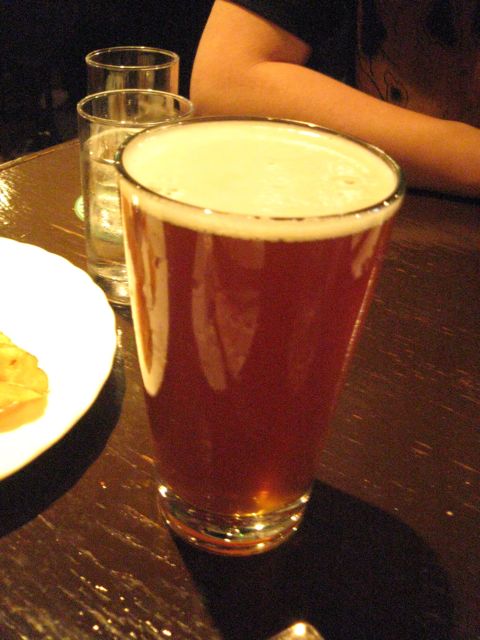
I do need to get back home some day.
So, bearing in mind that we were going to be up early the next day, and that the trains would be shutting down soon, we headed back home.
IMPORTANT Note for everyone in the Tokyo area!
I also noted, just at this point, a sign on the wall indicating an upcoming date – the 20th of April (which means I need to post this now). I hailed our waitress, and she told me that there was a beer fest coming up, with 100 beers competing. So, for those of you reading today, and in Tokyo, call up Popeye at 03-3633-2120 www.40beersontap.com for details.
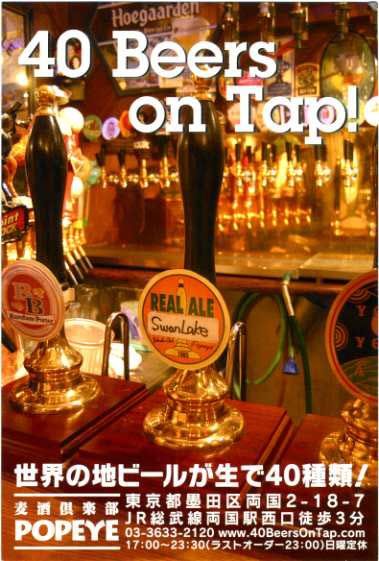
(is it just coincidence I got to this point just now?)
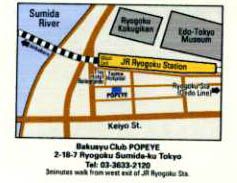
-
Next!
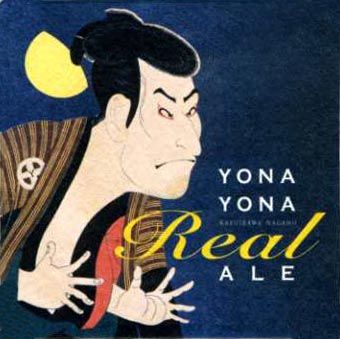
-
The first ramen shop wasn't opened until 1910? That was the same year Korea was forcibly annexed.
I've got to practice doing that thing where he flips the spoon out extended into the air (ala John Travolta).
-
March 24 – Semantics
Warm and happy, we’d cut back through the alleys to our apartment, and put away our shopping.
This gave me some time to reflect on money. 6,000 yen doesn’t go very far, does it?
However, for that money, you get all the styrofoam stretchy padding you could ever want. Plus, plastic bags out the gazoo (don’t ask me what a gazoo is, I warn you). After only a couple of days here, the amount of packaging refuse was getting higher and higher. Add to that the fact that there’s limited recycling, and I begin to see how Tokyo Bay is being reclaimed.
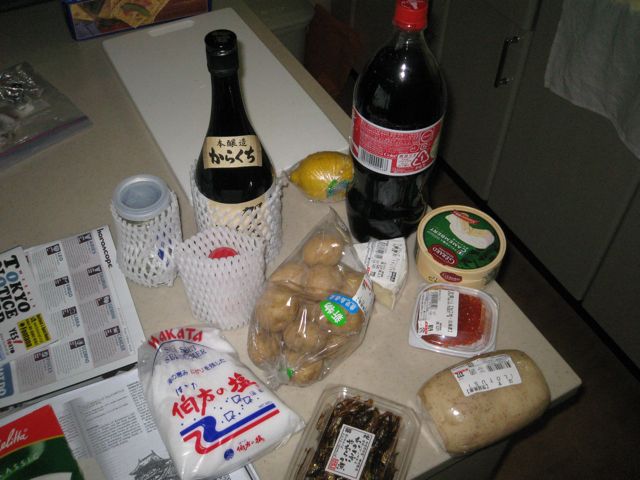
Unwrapped, some mysteries are revealed.
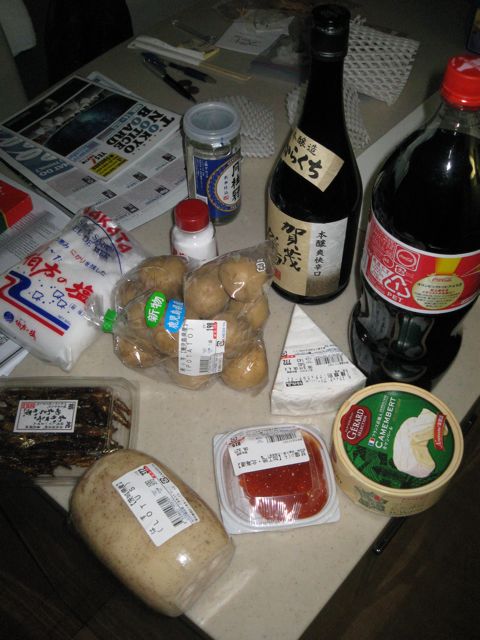
There’s little fish, fried up and sweetened. There’s a piece of lotus root that’s going home as a souvenir (I”ve been dying to do Sichuan hot pot). Some ikura as a writing snack, along with a wedge of Brie for the crackers. And then there’s a camembert and some pleasant little potatos. I’ve got a lemon around here somewhere, too, and I picked up table salt and a bag of sea salt.
I’ve told the boy I’ll make some lemon boiled potatoes with hot camembert one of these mornings.
The coke is obviously for Scud, and I’ve secured a back-up Ozeki One Cup sake in case of emergency. For the apartment there’s a non-descript bottle of sake for writing with.
The Yebisu is already in the fridge.
I tried looking up the sake, and found an interesting description of the word Karakuchi (辛口). This piece in Everything2 traces how the meaning moved from “pungent mouth” to salty (chilis are pretty modern here) to spicy. Then the writer follows the association trail from salted to dry, which attaches karakuchi to sake as a description of neither spicy or salty, but rather of “not sweet”.
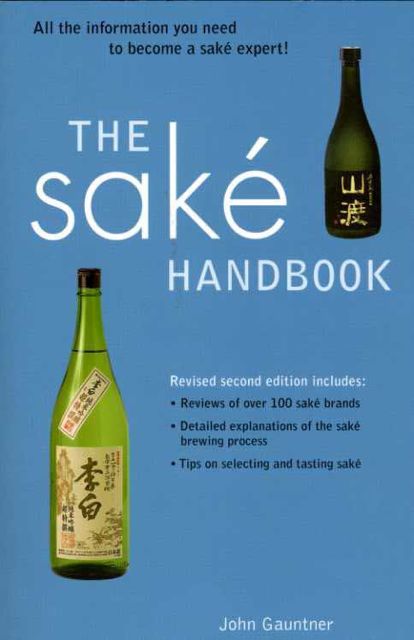
Now, from John Gauntner’s Sake Handbook (which I should’ve bought at the start of my trip rather than at the very end), we see karakuchi described as just “dry”, tied back to the SMV (Sake Meter Value), which is a measure of the residual sugar left in the brew. The scale, with today’s preference for “dry” sits around +3 as a neutral value, reaching up to dry sakes in the +10 range, but only going sweet to around -1 (there may be exceptions beyond this, but these outliers are considered “rare”).
Back to Everything2, they then show how this measure of “dry” was, in Meiji times, extended easily to beer and wine, as a measure of “not sweet” and so explains the use of “Super Dry” in some of the very crisp beers we see.
So, rather than having a burning hot, spicy sake, the bottle I picked up was a fairly neutral sake with not much sweetness about it. Good for sipping at while working on the machine.
I learn something new every day.
-
-
I made takikomi gohan with the middle part of the takenoko and clear soup with the hime kawa (姫皮 in kanji) called wakatake jiru (若竹汁), meaning young-bamboo-soup. Just when I started making stir-fry with the bottom part of the takenoko, ham, and green peppers, the bell rang. My sister-in-law brought us negi-toro rolls and nina (simmered green). So, I didn't make the stir-fry tonight.
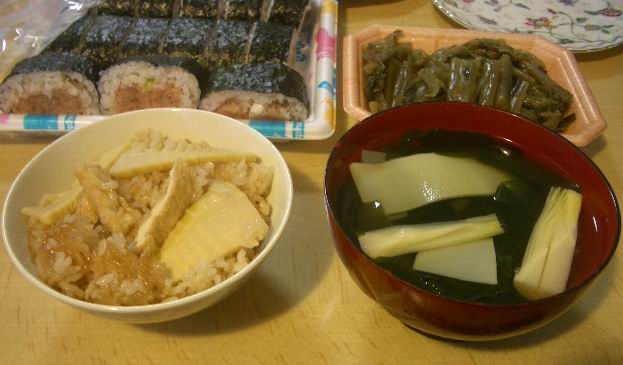
Both takikomi gohan and wakatake jiru were very good!
I'm hungry again.
-
These are fun!
Plus, I now have another excuse for falling behind in my writing!

-
March 24 – I Don’t Like Mondays
The morning had not gone well.
After some studying and a rehearsal, we went to the nearest Lawson’s to buy tickets for the Studio Ghibli Museum. From the ‘net, it’s apparent that you can’t just show up in Mitaka and wander in. The number of visitors is controlled, and that control is overseen by the demonic ticket machine in Lawson’s.
Everything went fairly well, all according to the step-by-step instructions provided on Studio Ghibli’s site.
Up to a point.
Luckily, we were in Japan. If you stand around looking sad, vainly attempting to get a vending machine to respond to you, someone will make the time to come and help you.
Unfortunately, when you rely on blind luck to be the cornerstone of your planning, sometimes things don’t work out. Our new friend – the Lawson’s clerk - was very sad to inform us that the next available tickets were for the 31st. Given that Scud would be over the Pacific somewhere, and I’d be in Hong Kong, that wasn’t going to work.
So, we adapt. Fate has been unkind this time. But, when the going gets tough, the tough go shopping.
Scud and I stopped back at Midtown in search of groceries. This kept us occupied for a short while, long enough for us to sensibly decide to get something to eat.
“Sensible” isn’t a term we use very often.
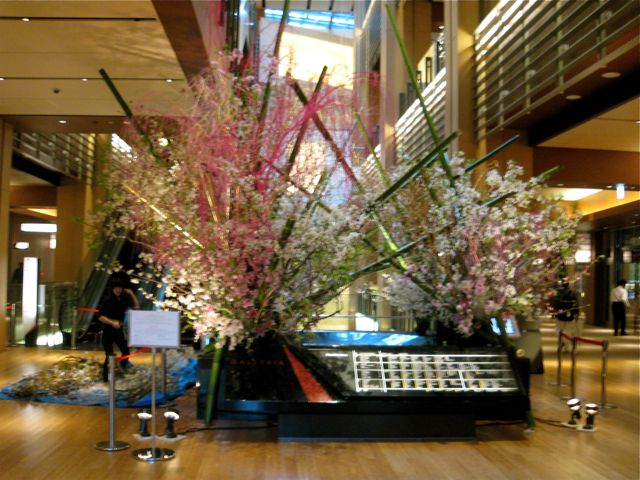
But the restaurants in the mall were still not open (the cafés were, but that didn’t suit us). We admired the preparation of the daily flower display in the main hall, but, after a few minutes that got old. We needed to get moving.
It was cold and wet outside, the drizzle sending a chill to seep into our bones. It would make sense to find something comforting to lift our spirits.
So, we went back to Tsurutontan.
Normally I’d try to get as much variety as I could in my dining, but this was relatively early on a Monday, it was miserable out, and there were still things on their menu that I wanted to try.
Another draw to Tsurutontan is that they’re open pretty much all the time, which meant we could drop in without having to wait in line.
I started by chasing the cold away. A Miyagi Hidakame (?) jizake. This I asked for warm. It may not be the best way to enjoy this sake, but it was the right thing at the right time.
I loved the presentation, the little wooden box around the warm flask, and a rough and tumble cup to take it with. Scud indulged in a sip, and agreed that it helped to change our perception of the day.
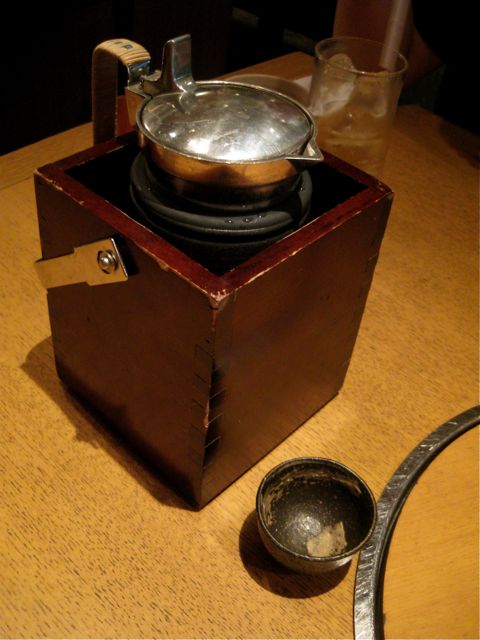
The smell on this heated was wonderful. Extremely full and rich, not what I’m used to in ordering a flask back home. I am definitely going to have to look up the artisan sake makers in Vancouver when I get back……and November is a wonderfully cold, wet, and miserable time of the year for drinking warm sake……well, actuallly that sums up Vancouver for most of the year, doesn’t it?
Scud’s udon arrived, Jidori no udon.
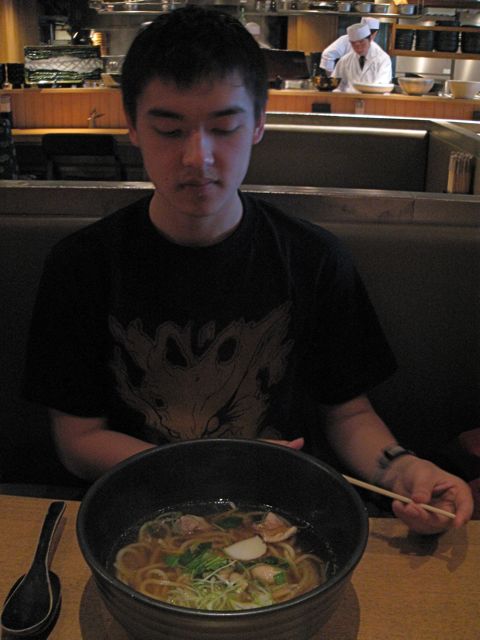
This was a chicken broth, with chunks of chicken meat. After the unfortunate hot and sour experiment of the other day, he wanted something he could rely upon.
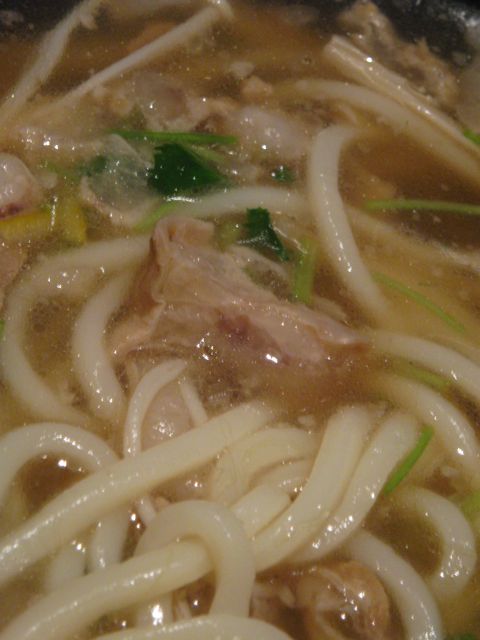
“The Hinai Jidori is the famous chicken from Akita Prefecture”. That’s what the menu told us. It was, I will say, extremely soft and pleasant, and the broth was all you’d ask for in a chicken soup.
The Hinai Jidori is a cross of the local Hinaidori (male) of Akita with a Rhode Island. This is a free range (ground) chicken, “raised in fields of clover, and drinking from the freshest of waters”. I don’t believe the chicken get massaged, however.
Reading up on it, there are three famous brands of chicken in Japan. The Hinai Jidori, Nagoya Kochin in Aichi Prefecture, and Satsuma-jidori in Kagoshima Prefecture.
Both the Hinai Jidori and the Nagoya Kochin habe become caught up in scandal recently, however, with the processors sneaking in everyday chicken for some of the products. According to the
this has been going on for ten years. Mind you, this particular scandal revolves around the use of everyday meat for smoked products. They figured “no one will tell the difference”.
Reading the related posts, which all seem to be back from the end of last year, there’s been a rash of “irregularities” in the food industry, ranging from mislabled chocolates (Sapporo’s Ishiya’s Shiroi Koibitio), falsified expiration dates on mochi (Akafuku from Ise, who’ve been in the business 300 years), more falsified expiration dates on seafood products (Senba Kitcho from Osaka), and even McD’s has been embroiled in taking their salads past the due date.
It’s always interesting where a bit of reading will take you. But I should get back to the main thread.
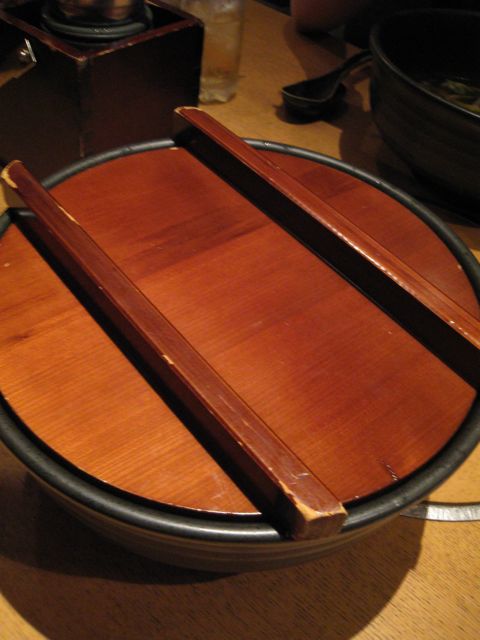
I had no concerns regarding my udon. I was having Naniwa no kasu udon. Now, I’m probably wrong, but what I read is that “Naniwa” is an older name for Osaka. As horumon is an Osaka specialty, I’m assuming that this, likewise is from the Kansai, a soup of “intestine of cow after removal of fatty substances, dried, and boiled with udon.”
When you’re already committed to offal, what more could possibly impact your decision?
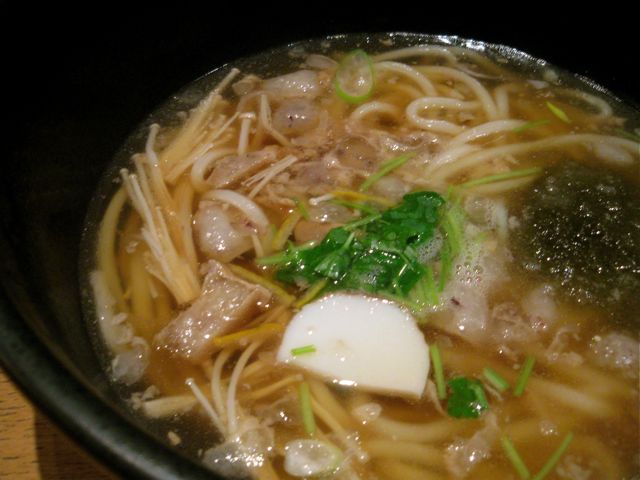
This was an interesting dish. The intestines had a certain amount of crunch to them, while the fat was still there to lessen the impact. But more of the fat had worked into the broth, giving it an extremely comforting, decadent feel. I wonder what this would’ve been like if they hadn’t removed the faty substances already?
And I really like the attitude here. Tsurutontan wants people to enjoy their udon. If you want double portions of noodles, all you have to do is ask, and they’ll bulk it up for you for free.
We bulked up.
The fat, along with the crunch of the intestine and the balance of the tobiko mushrooms had me quite content. A little sake to clear the grease, and I was back in for more. The Boy, likewise, was face down in his bowl again.
Yup, it may be a cold, wet day in Tokyo, but warm sake and good udon can make you appreciate even that.
Note: edited to fix the links
-
Hiroyuki,
That's definitely it! It's odd, coming from Vancouver, but I've never had that. For some reason it doesn't get onto the menus there (is it all bought up for Japan?)
At least locally, we call this kazunoko kombu here in Vancouver. That is how we've always called it in the Japanese community.
You might try asking for it next time you're in Vancouver, or requesting it a few days in advance, since it does take some preparation. I'm sure you can also buy it from Fujiya or Angel Seafood. My mother usually prepares kazunoko kombu for Oshogatsu (New Year's).
Thanks, Sanrensho,
After this trip, my plan will be to order some things in advance through the in-laws. There are so many things I hadn't thought about before, and others, like herring roe, that have drifted out of the sieve I call a memory. If I can get back to Vancouver in November (as tentative a plan as any of mine) then I intend to do some experimenting.
-
1. Fish caviar cake: Isn't it komochi kombu (kombu with herring roe). It's a great souvenir for Japanese from Canada.
Hiroyuki,
That's definitely it! It's odd, coming from Vancouver, but I've never had that. For some reason it doesn't get onto the menus there (is it all bought up for Japan?)
2. Pickled vegetable in the cod dish: It looks like simmered daikon leaves and stems to me. Other possibilities: Takana, nozawanaThis one's tougher. There was some similarity with the takana, but what they served at Morimoto was chopped down and marinated such that it was hard to draw a visual correlation.
3. Yamagogo: Yamagobo (lit. mountain burdock root)?Yup, that's the one. It's just the trick of getting the word from the chef's mouth to my ear and out the pen. Is there a significant difference between mountain gobo and just plain gobo? Now that I've got the right spelling, it's interesting to read that Japan is one of the last places where this is popular (and in Korea. Yoonhi looked at this and said 'burdock" right away, and then looked at me with that "how many years have I fed you this?" look).
4. Shako: I've never seen or eaten such bright orange ones. Were they really shako. I thought they were mushi ebi (steamed shrimp).The chef said shako, so I'll go with it. That long body seems familiar to me as squilla from eating in other places.
5. Hiroki (sake): I did some googling and found it's from Hiroki Shuzo in Fukushima (福島) prefecture.Thanks a million for this one, Hiroyuki! When I'd tried to google I'd gotten sidetracked on the Hakushima note that I'd written down. I followed your path and found this note on
Hiroki Shuzo tokubetsu daiginshu. The article (from late 2006) covers a review of sake products not yet (at that time) available in the States. Hiroki had taken a Gold medal in the nationals. It's designated as a "special" (tokubetsu) as the sake is itself a blend of two different rice polishes - a 50% daiginjo grade and a 55% premium ginjo grade.
6. Takenoko (bamboo shoots)! It's that time of year again. I bought one yesterday, and posted photos of it in the shun no mono (spring) thread.Aren't they pretty? I used some last week in some Thai cooking. But that doesn't belong in this thread.
Thanks again!
Peter
-
March 23 – Post script
As expected, when I’m in a cheerful mood like the one I left Morimoto’s with, I didn’t make it straight home.
I tried to talk Scud into joining me, but his heart was set on the laptop, so we parted ways just across the street from our turn-in to the Oakwood. Scud would go home and I would check out The Hub.
The Hub advertised an “English style” pub. They also advertised cheap (well, 350 yen) beer. However, once I entered and ordered a pint of their own brew – Hub Ale – I found that the 350 yen didn’t apply. It was 800 yen for a pint of ale.
Still, I was on a mission to check out the beers of Japan, so I couldn’t really balk.
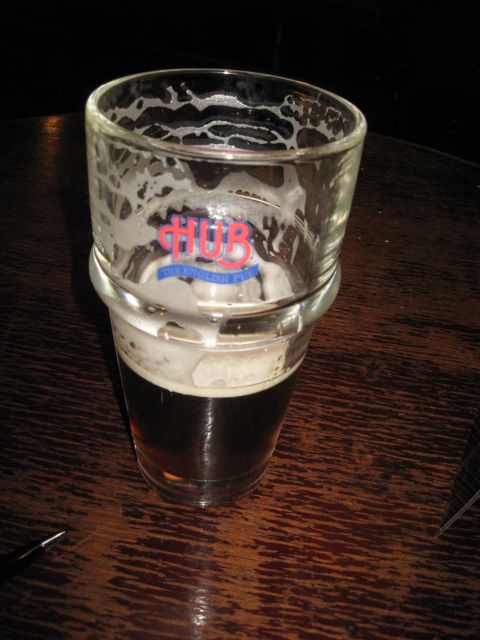
The ale was disappointing, the more so as the colour and head looked very good. But it just came torough too weak in the finish.
The crowd (although it wasn’t what I’d call crowded) was pretty much all Japanese, made up of a long table that appeared to be all one company out for an after-work celebration. Mostly men, but there were a couple of ladies in the crowd, too.
The one beer was enough to settle me, and with that I headed home, taking just long enough to read this marvelously anonymous plea for civility.
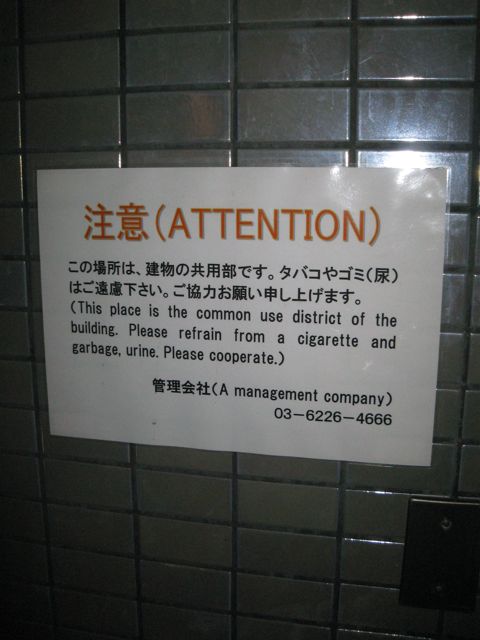
Next: March 24 (you thought I’d never get there, didn’t you?)
-
March 23 – In the Lair of the Iron Chef
Our journey home took us back to Roppongi by way of Shinjuku.
If you know the town, or have a map handy, that gives you a pretty good idea of how efficient we can be.
Still, it gave us the opportunity to admire the panic crossings and the jam-packed atmosphere of the uber-modern side of Japan. Scud was too grouchy at this point to do much in the way of pictures so it seemed a reasonable time to head back to Roppongi and our place.
That gave me time to consider our dining options. Scud said he wanted sushi. We still didn’t have a red book, but I checked the computer’s list, and then cross checked against the now-battered Wining Dining guide (I was going to have to make a concerted effort to find Kinokuniya, we’d missed it this day).
What came up was Restaurant Morimoto XEX.
XEX? There were loads of places with XEX attached to the name in this advertising pamphlet disguised (poorly) as a guide book.
XEX is the brand name for the high end elements of Y’s Table’s portfolio of restaurants. Y’s Table, or rather Y’s Table Corporation, is an investment group that manages both the XEX range, and franchises fast food and casual restaurants as well. With money from Mitsui and Daiichi Mutual, there’re some deep pockets here.
So, we can trace the money. What else?
Well, there’s Masaharu Morimoto, the chef himself. While he wasn’t in residence this evening, the place does bear his imprimateur.
Okay, you’re going to have to forgive me, but I don’t watch tv. For child rearing reasons – primarily – we’d decided early on that getting a dish was just going to guarantee the kids a steady diet of pablum through the age of….oh…say 42.
(Yes, Scud does hate us for this).
So, stuff that most people consider common knowledge of everyday life can pass us by.
Iron Chef, for instance. I’ve seen a couple of the old Japanese episodes in Bangkok, but that was a long, long time ago. I had the general gist of what happens on the show, but as to the names and faces….forget it.
I also haven’t been to New York or Philly, so I hadn’t had any contact with his places there, or with Nobu New York (only the London side, I’m afraid). Likewise, the invitation the Sony Corporation must have sent me to dine as a VIP in their corporate restaurant must have gone astray.
So, while chef Moritomo has had a stellar career, both on television and in the kitchens of some very good restaurants, our paths have never crossed.
In other words, I’m just plain ignorant. But you should be used to that at this point.
Looking him up after the fact, he’s a native of Hiroshima, where he had studied and opened his first restaurant. Actually, looking at wiki and his website, he’d started off wanting to be a professional baseball player, but a damaged shoulder put paid to those dreams. Luckily, he also liked cooking, so that’s what put him on the path that led him overseas to New York in the 80’s. And the rest we’ve already gone over.
The restaurant was tucked away on the back side of Roppongi, over near the tunnel. I’d thought it would be easy to get to, but this was overconfidence on my point. With the hills of Roppongi, too many streets turn into dead ends.
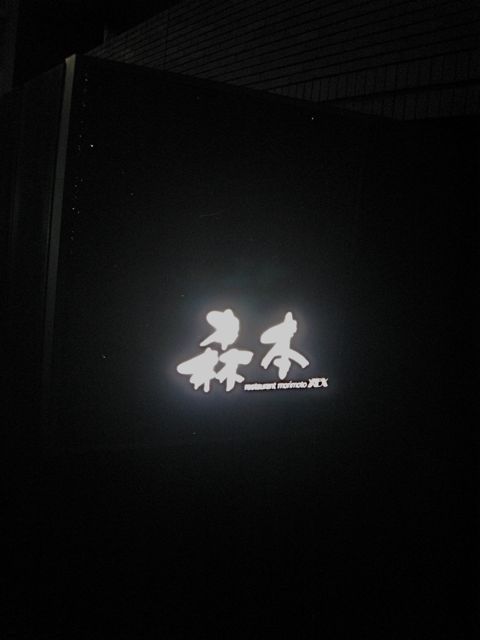
But, through blind luck, I did find it. Like many places here, there’s just the one name sign outside to let me know I’m where I should be. Luckily there was romaji on this sign. Luckily the sign was lit. Luckily I had Scud with me to spot it.
Inside, as expected, everyone was as gracious as you’d expect.
Now, I may have messed up slightly, but not to the point that I was overly concerned. I’d booked us for the sushi bar, as this was what Scud really wanted. But this restaurant – only opened in 2006 - actually took its Michelin star for its yakitori, which is done downstairs in a basement room.
But, ignorance is bliss.
We abandoned our jackets, sat ourselves at the bar, and gave ourselves up to our chef for the evening – Torohiro Nakayama.
I began with a cocktail of sorts. Shochu (potato) with grapefruit juice. Scud had a taste, and voiced his approval. But he was going to make do with tea.
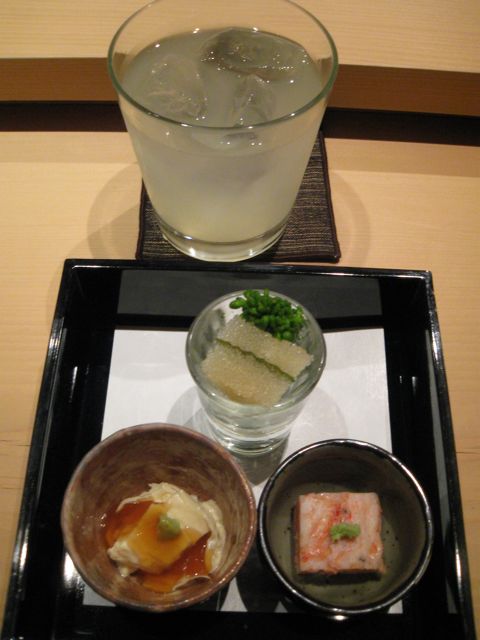
Our first course was a fish caviar cake – crunchy tobiko feel, but just a little rubbery – fresh tofu “skin” with a sweat soy and a dab of wasabi – a nice clean taste; and a shrimp and fish mousse, again with a dab of wasabi – soft and rich.
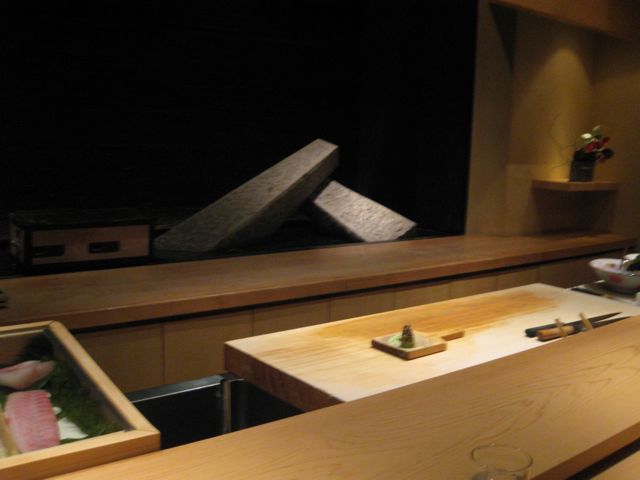
The edge taken from our hunger, there’s time to contemplate the room. A nice open space stretches back behind the bar, with running water providing a pond around two toppled obelisks. Grills are placed here, in the water, for cooking.
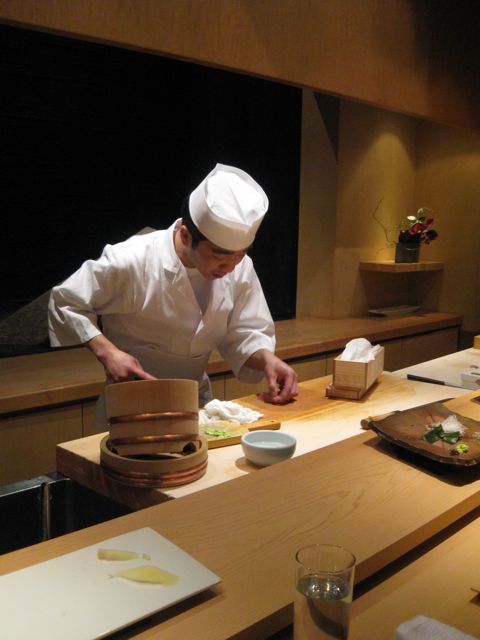
The work areas are all clean, straight slabs of wood.
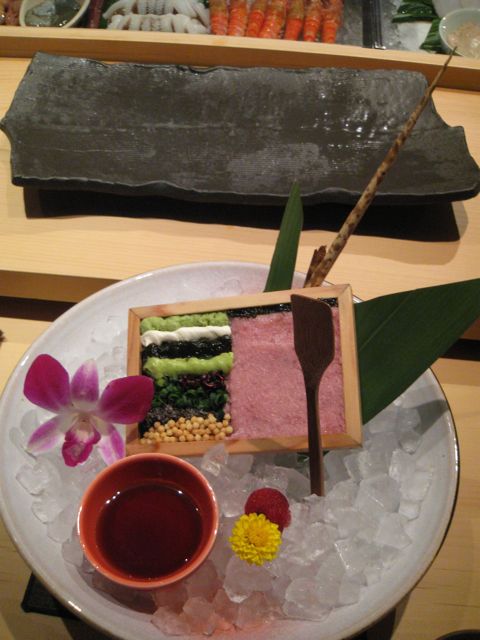
Our second course is a toro tartare – the tuna worked down to a paste – topped with a line of oscetra caviar, and braced by an octet (if I count right) of garnishes – wasabi, sour cream, seaweed, avocado, shisho, “saltiness”, nori, and rice pop – each for a particular flavour or texture. There’s a sauce of dashi and soy, and a small mountain peach (Yamamomo), bashful behind the yellow blossom.
I’ve made it clear in previous posts that I heartily approve of dishes eaten with shovels. With the little spatula we’d take off a piece of the tuna, an egg or two of the caviar, and then play with the toppings.
I’m also a big fan of fresh ground wasabi, something I’ve grown used to in Bangkok. The powder tends to concentrate the flavour too much, and can be overpowering at times, which I don’t find to be the case with the root grated and worked down on the spot.
This was fun, and Scud approved.
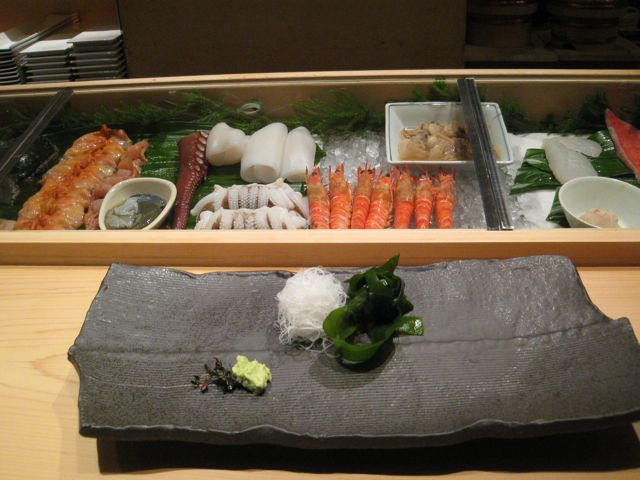
Once we’d finished that, our serving tray became our primary focus for the forthcoming sushi and sashimi.
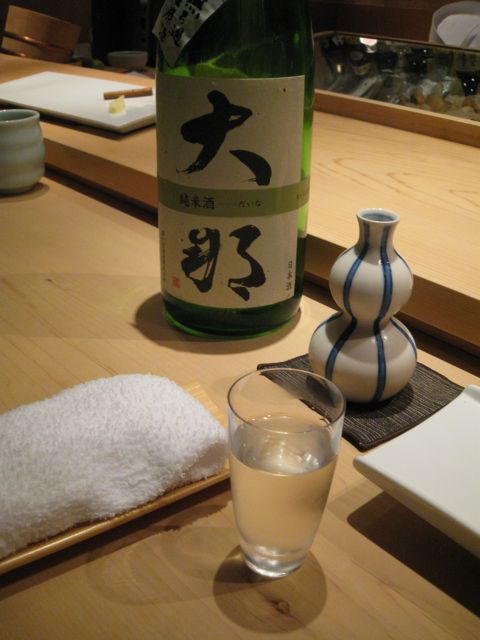
With food, sake is by far the better accompaniment. I asked what they had that would be interesting, and a Taina unfiltered sake was recommended. Fairly full in the mouth, and a little towards the sweet side.
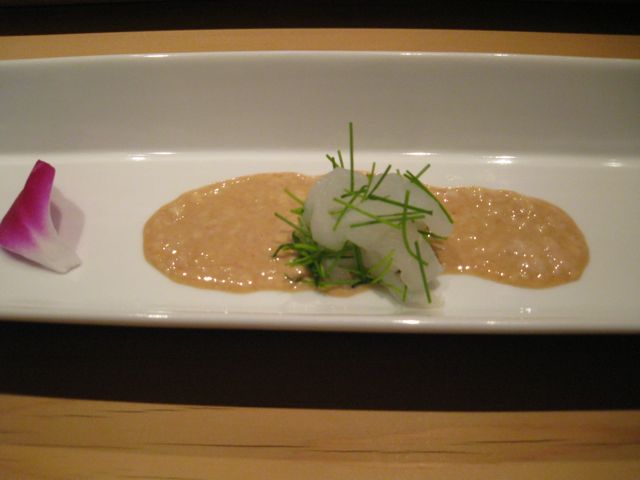
With this a filet of of fish (but not the McD type). This was kawahagi (filefish), a flat fish. It came with shards of spring onion, and a sauce worked up from its own liver. The flesh has a firmness and certain austerity to it, helped out by the richness of the liver.
Here’s a link I found on preparing the kawahagi.
Next was a sashimi of mirugai that was so crunchy and fresh that we forgot to take a picture of it.

Then a piece of black cod that had been cooking on the grill over the water. The sweet soy had caramelized lightly, giving a tanned sheen as the cut waited there on the burdock leaf. The meat flaked away, and then broke down sweetly once it was in the mouth. A bit of the pickled vegetable (what is that, I wonder?) to clean the mouth for the next bite.
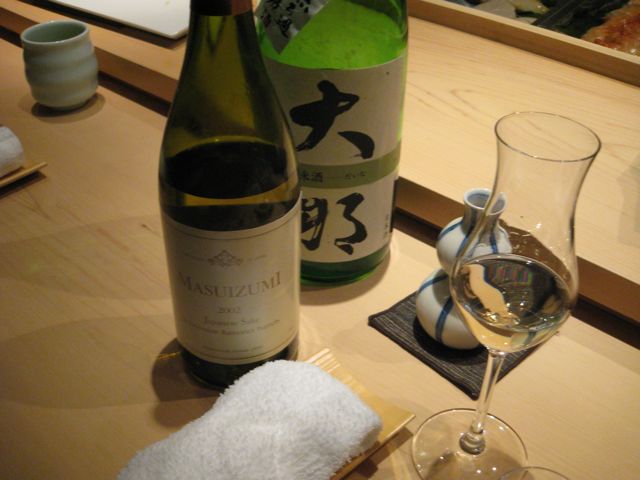
I’d been enjoying things so far. Having a glass of sake sent around for me didn’t dampen this mood in the slightest.
This was interesting, and something I’d read of. The sake was Masuizumi, from Toyama Prefecture. They’re well regarded for their ginjoshu, the tasting notes refering to a “narrow” flavour, “free from too many distracting elements that would only clutter it”. That may be, but in this case they’ve oaked the sake in French casks from Domaine Ramone, whose name seems to come up mainly in conjunction with Montrachet in Burgundy (which isn’t bad company, at all).
The sake is a 2002, having been aged, which isn’t the norm. It’s still very clean, there’s just that overtone of wood about it, softening the flavour.
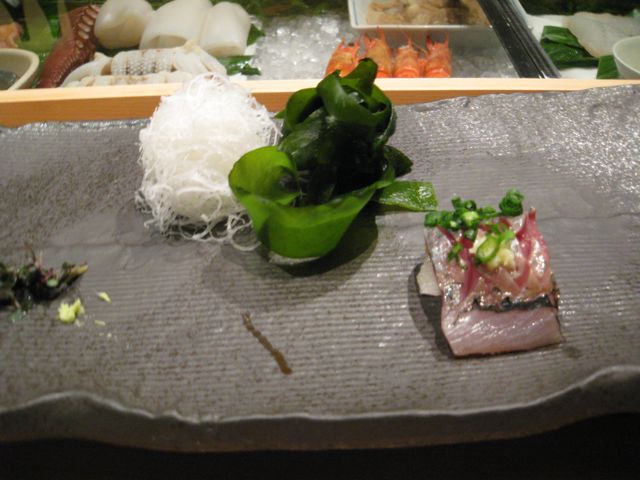
I take a pretty piece of horse mackeral (aji) with this, the back scored open and dressed with fresh greens (and we Greens can get pretty fresh). The fish is meaty, with a stong flavour.
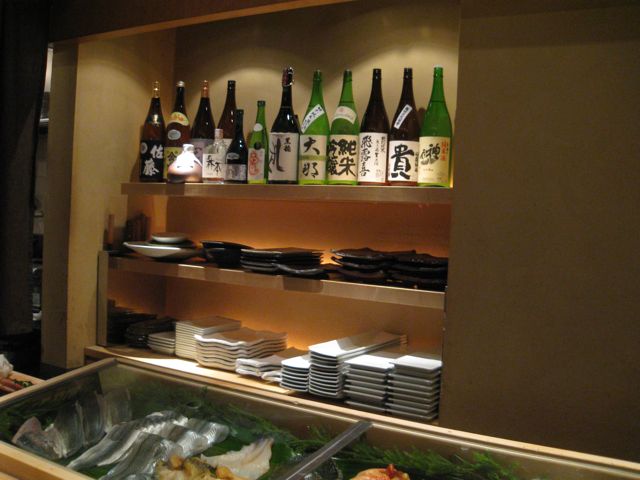
I’m enjoying this sake, presented, I should mention, in stemware, which does a nice job of concentrating the nose for me (okay, it gives me the opportunity to bury my over-sized shnozzer in something large enough to handle it).
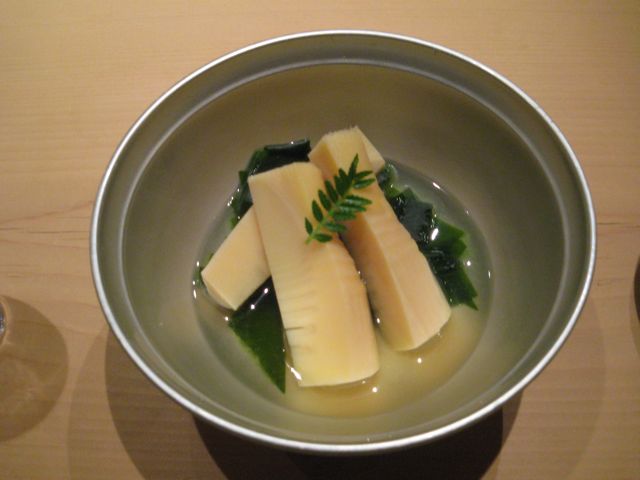
Steamed bamboo next. The liquid is excellent, and I wish there was more. The bamboo itself is unlike what I’d had in Kyoto. There’s not the crisp element, but rather this fllas apart in my mouth. I play with that, and introduce some of the kelp, which has a great texture as well.
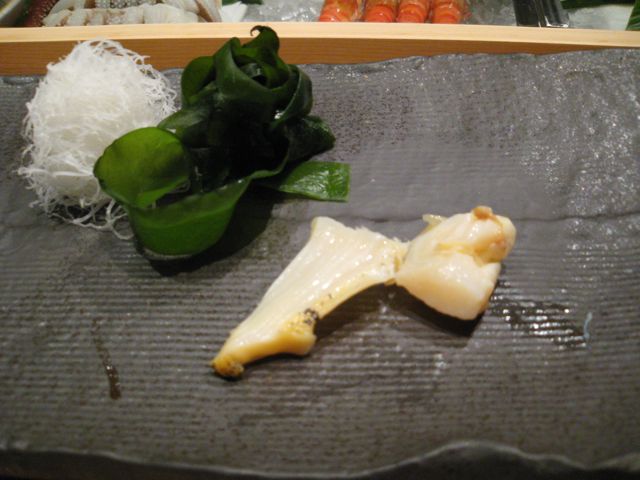
Then comes tsubuka (I believe that’s what it was). This tasted like conch, although conch would be horagai?
I watched Nakayama san mix up the liver fresh for a new serving of the fish for someone.
His assistant, to my left, is making an outside-inside maki, the rice contained in the rolling with a piece of cloth that it’s rolled in. The cloth removed, the rice drops ploppingly from the the nori like maggots from a hunk of rotting meat….okay, that may not read that appetizing, but it looked really good! On my neighbors plate it slowly came open, releasing steam in a nice bit of theatrics.
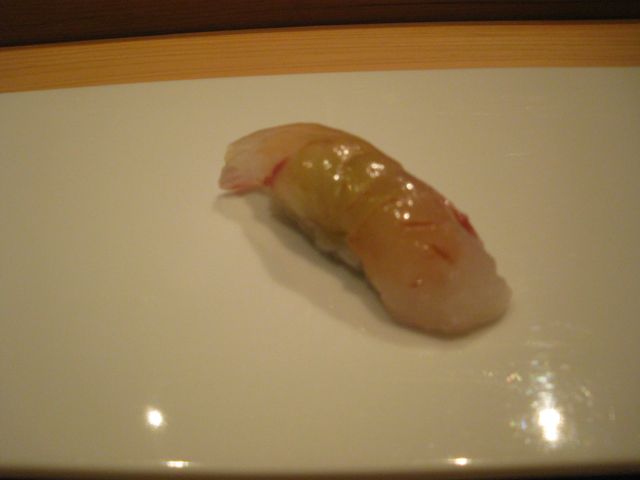
And then there’s a piece of sushi. Ebi. Sweet and soft. Translucent, it plays the light off of the colours of it’s skin, and underneath. This is how I like ebi.
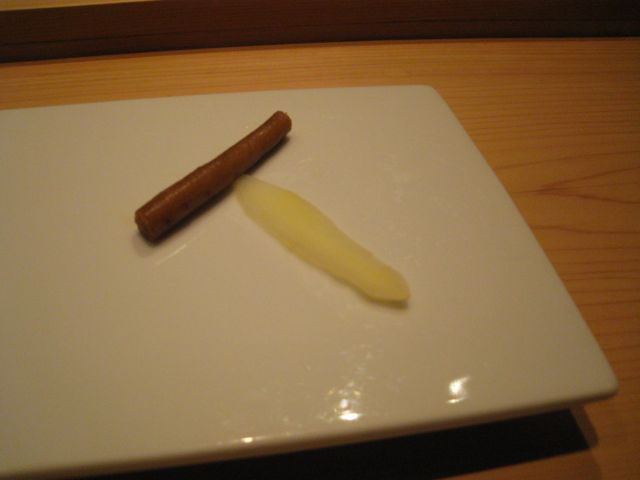
The pickles on our plate are a long, crunchy brown root I don’t recognize, and the ubqiquitous ginger. I’m told the root is Yamagogo. Scud and I aren’t quite certain if we should go ahead and eat them, or if they’re to go with something else, but we figure, “what they heck”. We’re foreigners.
We ate them.
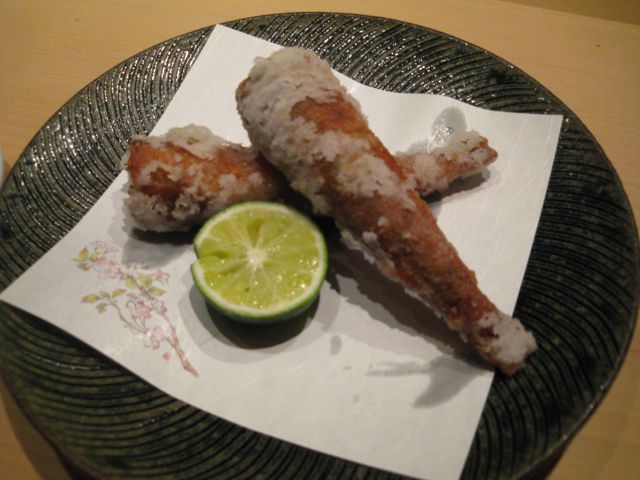
There followed a lightly tempura’d thing. This I was told was meshikai katsudaage. Soft, with a taste of a fish mousse.
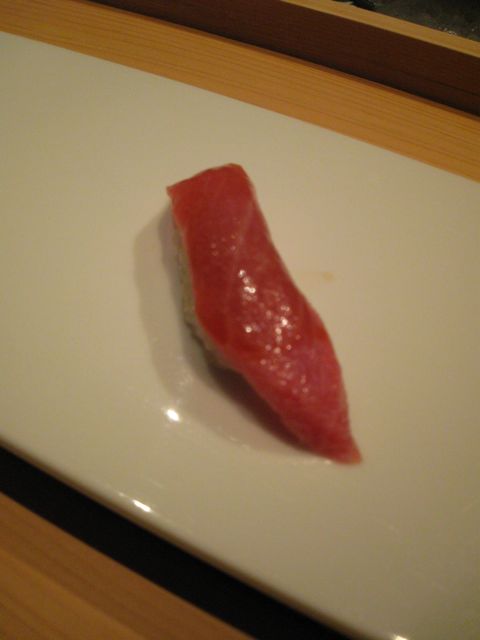
And a nice piece of tuna. But the rice is the real highlight. I should have mentioned that with the ebi. Each grain stands out, and the taste, with the vinegar and the sake in there, is very, very good. I spend a certain amount of time just chasing the grains of rice around in my mouth.
I watched his hands as he prepared this. They were hard to see, they were moving that fast. Like the fellow who did our train tickets for us in Kyoto.
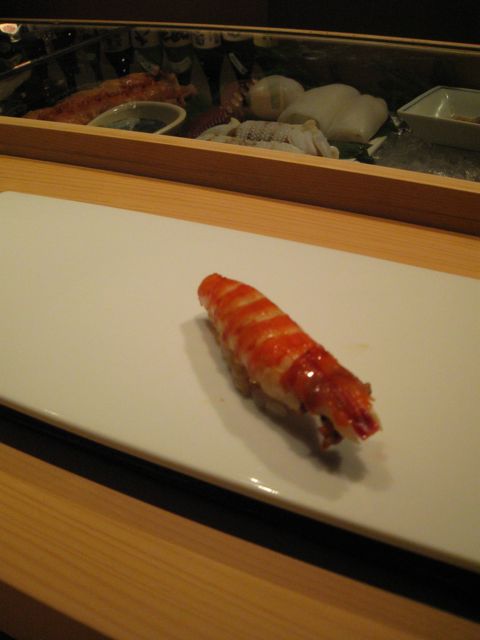
I know this as squilla, or mantis shrimp. The Japanese would be shako. A nice contrast to the ebi earlier, and again, an excuse for me to enjoy the rice.
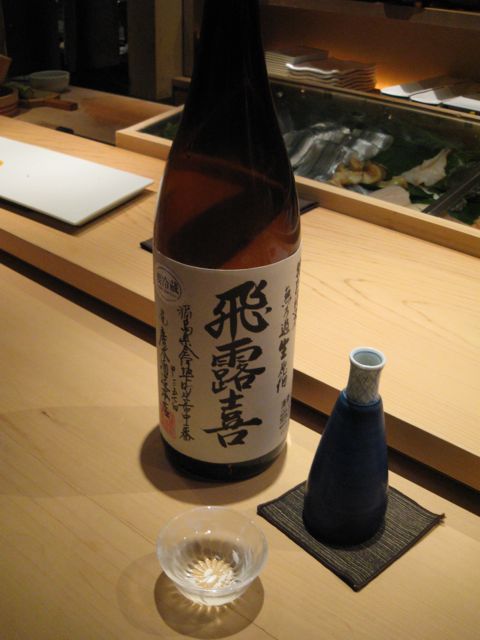
I find myself, inexplicably, out of sake. This time I go for something a bit sweeter – Hiroki from Hakushima in Hiroshima, I believe, but I may well be wrong (I usually am). This is noticeably sweeter than my other sakes, and stands well with the next dish.
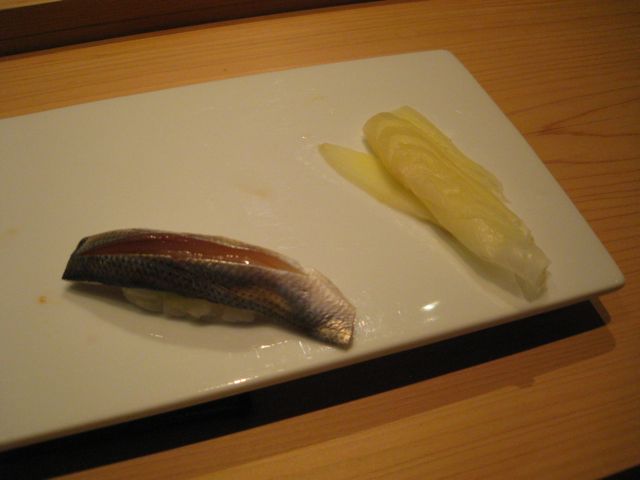
The next dish being char, split down the back to reveal the the oily meat underneath. Again, a strong flavoured fish, and one that goes well with the sake they’ve proferred.
My miso (again, I was having too much fun to shoot) was thin compared to what I’m used to. But it was packed with fresh greens.
Next was a kanpyomaki, a roll. Kanpyo is a dried gourd that shaved and then brined and cooked in dashi with sake, soy, and sugar. This had been citrused up with orange zest. Scud and I lingered over this as I finished my sake.
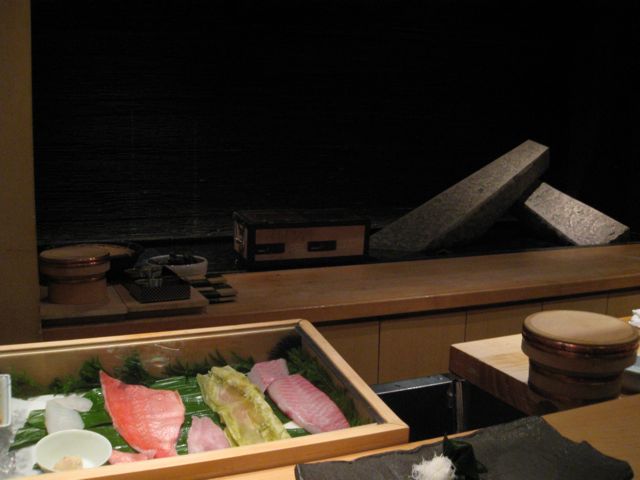
We passed upstairs for our dessert, to the lounge. This is a room for champagne lovers, done up in Dom Perignon bottles, with comfortable couches and lighting that is way too low to allow for any photography….at least not without disturbing the other guests up here. The lounge is broken into quadrants, with Scud and I holding down the corner farthest from the fireplace.
For dessert I went with a tofu cheesecake, and Scud the crème brullee. It seems they’ve been shorting the students on crème brullee at his school. I’ll have to have a word with them about that. He says there’s been no caviar or foie gras, either.
The cheesecake is good enough, but not spectacular. The crème brullee was nicely done, touched up at the end with a grating of citrus skin (mikan, I think).
I decide to put the lounge to the test, and try a martini. Bombay Sapphire, with a sliver of lemon skin is how I order it, but what comes is a wide shaving of lemon peel perched on the side of my drink, with a steel spiked olive in there at the bottom of the gin.
Oh well. This isn’t a martini nation.
It doesn’t taste too bad, though.
In all, a nice meal, one that made up for the poor lunch we’d had, and the late start to our proper dining in Tokyo. We collect our things, thank the staff, and head back home, brazing our way through the pimps of Roppongi.
-
March 23 – The Bridge of Cosplay
Scud was still thirsting for more, but the Sunday was rolling on, and I wanted to do Harajuku Bridge. After Scud had dropped 3,000 yen on a 9 Tail Fox Demon t-shirt (it’s a Naruto thing), I figured it was time to move on.
I had a destination, and I had a restaurrant picked out. I convinced Scud that both were worth our time. He decided he should trust in his father’s sage advice.
Not a wise decision.
First, crowds.
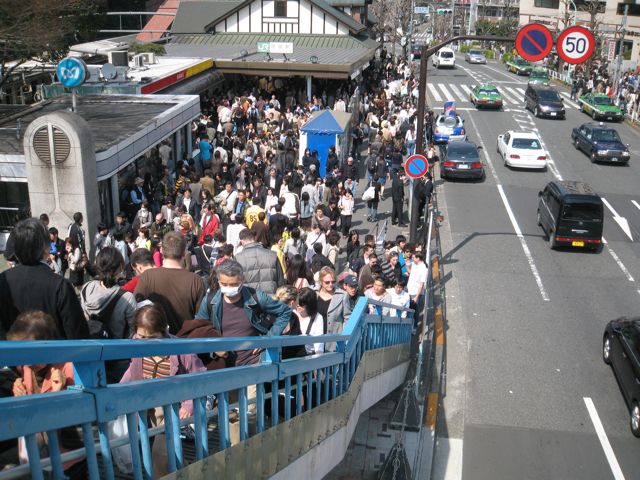
This place, on a Sunday afternoon, is busy.
Second, I’d come here for the cosplay. Years back I remember seeing great photos of crowds of wildly dressed teens, and legions of Elvis impersonators.
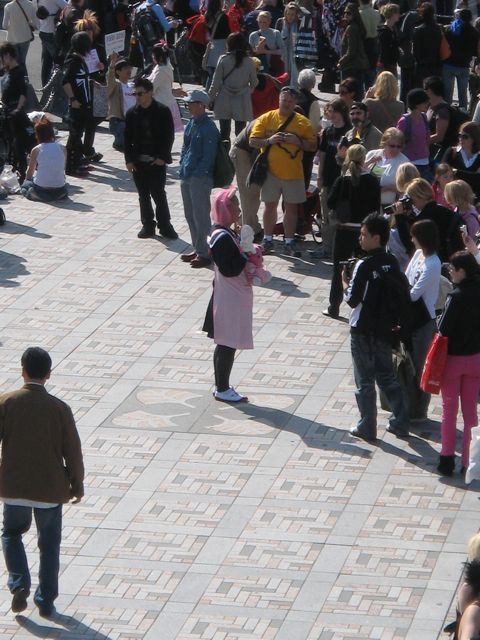
What we had, instead, was a small display of folks in costume, and a legion of gawkers (of which we were two).
Third, lunch was a disaster.
I’d had a couple of options planned out for lunch dining in the area. Both of these required a bit of a stroll, but nothing too strenuous.
Unfortunately, Scud’s patience was running a bit thin, and, like his mother, it gets really stretched out when hunger is involved.
Our first target, contrary to what it said in the Wining Dining book I’d purloined from our place said, turned out not to be open on Sunday lunch.
The second place was closed, too.
Do you know how hard it is to find a place to eat when you need one?
Finally, we ended up in the side streets off Meiji Dori, those small alleyways of boutiques and neat music shops (and darn few restaurants), and came acrossYoogee’s. I suggested looking a little further on for something more interesing, but the look of death I got from the Boy put me in a different mind.
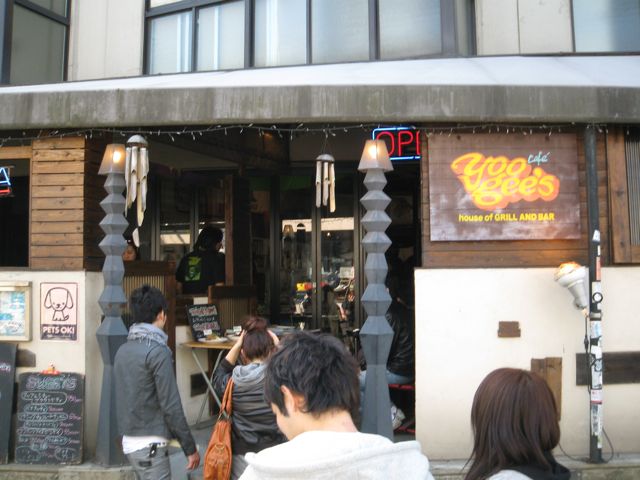
Lunch was, well, uninspiring. But it kept Scud happy.
I had a particularly black and Gothic looking curry, which cheered me up a little bit, while Scud had spaghetti, in large part as revenge, I suspect, to thwart my getting any decent pictures.
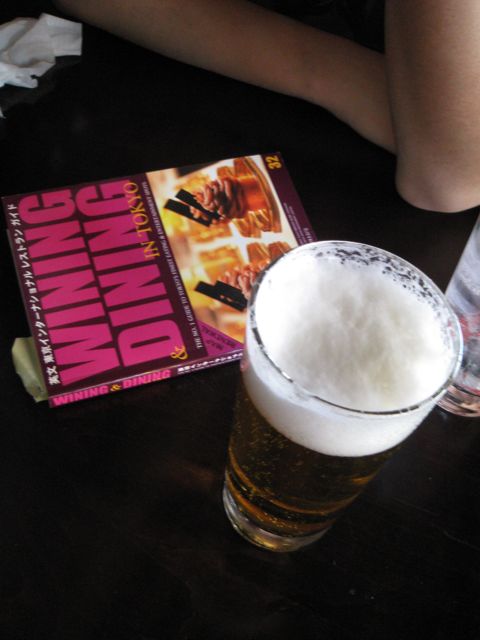
Wining Dining isn't a particularly inspiring book to work from, but it was at hand. It's typical of paid advertising books, and so I take things with a grain of salt (heck, I take my salt with a grain of salt), but it could still be useful......just not this day (Yoogee's is not in the book).
I actually didn’t mind the place for the feel and atmosphere. We had a good spot in the patio, which gave us a vantage point to observe the street traffic. And the décor reminded me that “Hawaii” is an icon in Japan, much as Vancouver is in Korea.
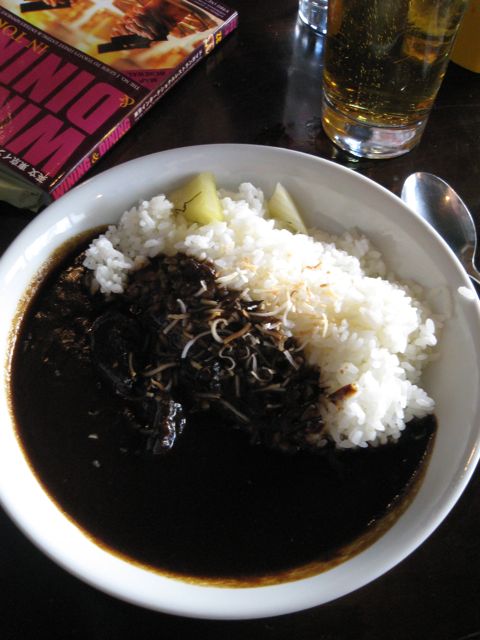
The curry itself was innocuous. It was a bit on the thin side, and, while I’d hoped for a certain amount of evil spice from that black roux, I was disappointed. It was mild, and just generally “tangy” more than spicy.
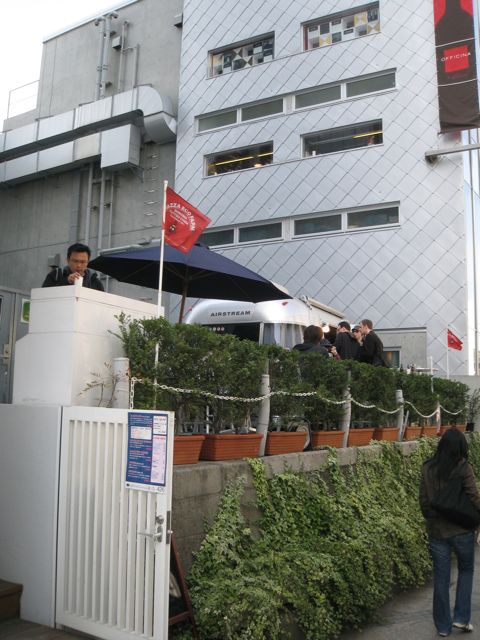
Of course, once we’d eaten we found restaurants everywhere, including one burger and hot dog joint built out of an Airstream trailer.
I figured from here we might as well cut up through the Yoyogi Park, and see the Meiji Shrine.
Secretly, I was hoping for a gang of berserk Rockabillies (did anyone else read Harlan Ellison’s classic of the same name) and perhaps the chance to catch a Mishima character hiding in the bushes, but I knew better than to mention such things to Scud. He was in a better mood, but not by much.
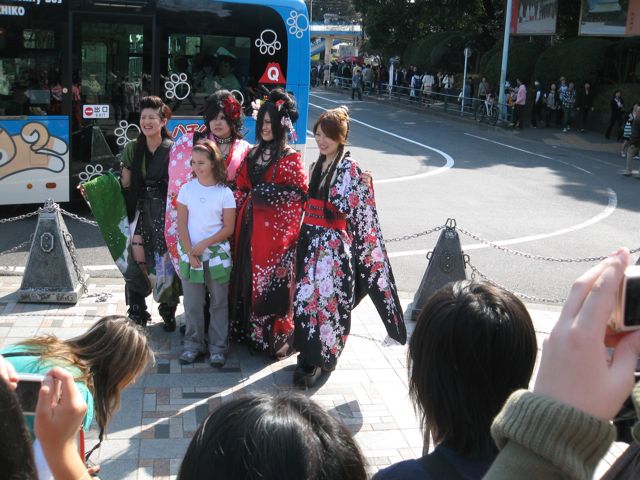
There was a bit more of a crowd out on the bridge, but it was still pretty tame.

After some idle voyeurism we headed through the torii into Yoyogi Park, towards the Meiji Shrine.
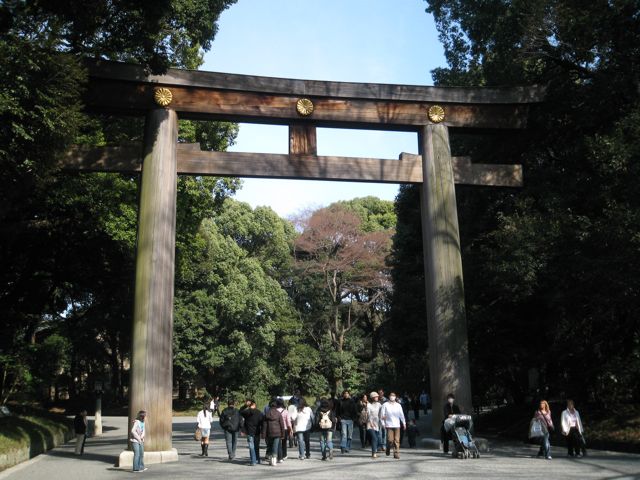
I was surprised at the casks.
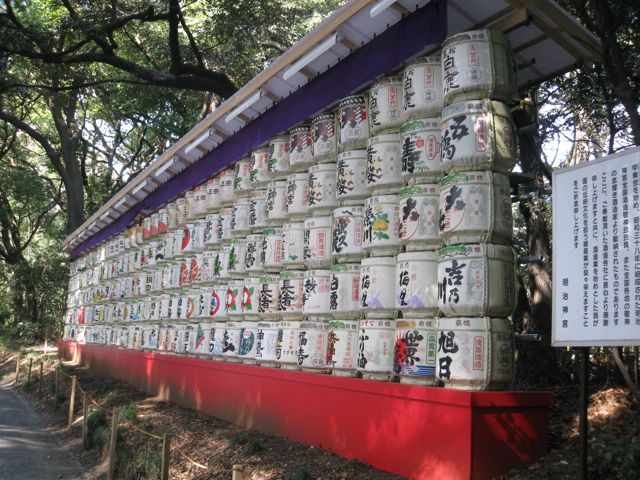
Not the sake casks (which are beautiful), but the wine.
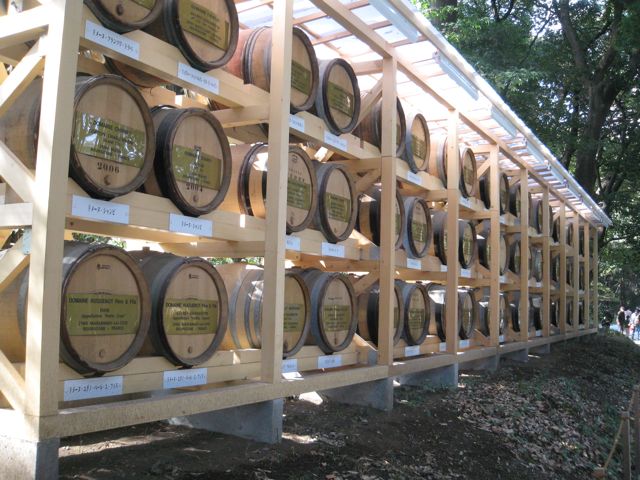
What I was seeing was the “Provenance of the Bourgogne Wine for Consecration at Meiji Jingu”.
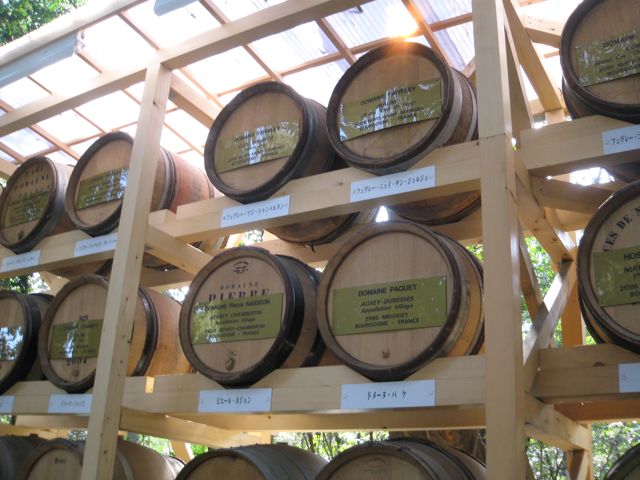
The Meiji Emperor had written
By gaining the good and rejecting what is wrong,
It is our desire that we’ll compare favourably
With other lands abroad.
The Meiji Emperor did, effectively “walk the walk” and carried through his desire for modernization by setting an example through his personal life (or as “personal” as his life could be). One aspect of this was in having western meals, and in having wine with these meals.

Quite sensible.
(If you're interested, here's a link that came up on this particular wine maker)
The wine is fairly modern. A relatively recent addition to the shrine’s paraphernalia. The casks are new, with the fresh smell of oak about them. This monument to the best of French culture is the brainchild of Dr. Yasuhiko Sata, an honorary citizen of Bourgogne, representative of The House of Burgundy in Tokyo, and chairman of Tokibo, one of the largest suppliers of medical equipment in Japan. A quick search, and you find his name amongst a number of charities, including those for land mine victims in South East Asia. Having spent a number of nights on the streets of Phnom Penh in the 90’s, I have a certain appreciation for that. Amongst many things, he owns an hotel in France (with a golf course). I’ll have to look up his hotel, the Chateau de Chailly Hotel-Golf, if I ever get to France (I am foiled in every attempt).
Anyways, details on this particular item are sparse. At least sparse in what we can find on the information superhighway. If there is more in this regards, please, let’s hear about it. I should think that there’s a good story in all this. (Maybe I can ask Thierry in Bangkok later on?)
While China is swiftly catching up, Japan is still the market for good wines in Asia, and the great families of Bordeaux and the rest of France are continually courting Japan (meanwhile, Thailand flounders under some of the most punitive import duties imaginable, and Singapore isn’t far behind). I know, you’d think I’d be taking advantage of my location to enjoy the good things in life. But, realistically, I can almost always hunt down good wine, but I can’t always find good sake, and I’ve grown exceedingly fond of sake on this trip. One must have priorities.
So, after several minutes of checking out the wine makers, Scud dragged me off to get on with the cultural thing.
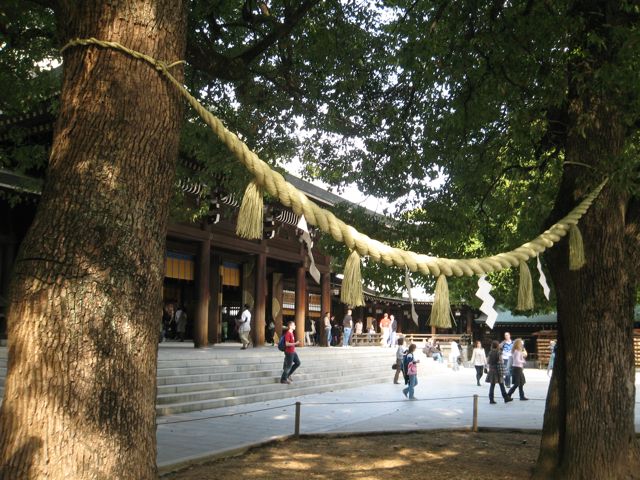
I enjoyed the park, even if we didn’t find any Rockabillies. Being a Vancouverite, I like being amongst trees, and the park is well populated with some admirable trunks. And the shrine itself fits in well.
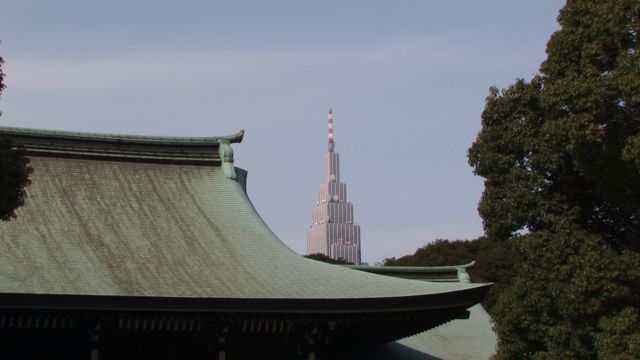
Weddings are the order of the day, and there were beautiful kimono and suits parading past in column. The shinto priests were passing through the crowds of tourists and worshippers, about their business. And the tourists, foreign and local alike, were milling about the gates, everyone behaving with proper respect.
Everything in its place, and a place for everything.
From here we headed North, into yet another world.
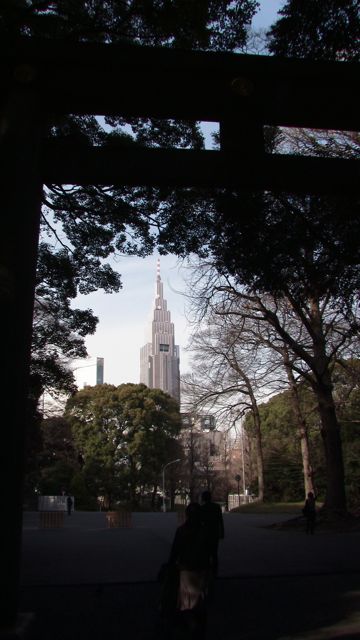
-
I've got a Japanese saw that I bought at some specialty hardware store in Vancouver (of all places) that I love for the odd bits and pieces.
Haven't actually tried it out on wood or such like.
I'll see if I can get a picture up.
-
Akihabara vs. Akibahara
Historically, the latter was correct, because there was a shrine there called Akiba Jinja (秋葉神社), but in 1890, a railway station was built there, and it was named Akihabara. Since then, Akihabara has become the official name, but there are still people who call the district Akibahara. To make things more complicated, the abbreviation for Akihabara is Akiba.
I used to frequent Akihabara when I was much younger (11 to 16 years of age). I was one of those interested in "electronics". I used to go there to buy transistors, resistors, capacitors, coils, and so on (IC chips were still rare in those days). Akiba has changed so much since then, and unfortunately, has lost much of its allure for me.
Thanks, Hiroyuki! Yup, I've seen it used both ways. Recently in that Metropolis piece, and also in some old stories, but it may be very much the "old" part.
Ah, the days when someone mentioned a "transformer" and you thought of power grids, not giant fighting robots.........
-
- Moxie at the D2 Hotel. WOW. We'd heard good things about this place and were very, very pleased-- Thai and Western food served in a very contemporary atmosphere (the entire hotel excels on design, quality, and customer service). I had a passionfruit margarita, and for my meal the papardelle pasta with a ragout of wild boar and vegetables; both were some of the best examples of their kind that I had ever tasted. My husband had lamb shanks with a massamun curry sauce and also proclaimed them to be excellent. For dessert I had a "warm cappuccino with cookies" that I think is the single best drink I have ever experienced, rich and creamy like a chocolat chaud, but not at all cloying or heavy. (Sorry about the hyperbole, but this place was a revelation-- and we probably paid about one half to one third of what a similar meal of this quality would have cost back in the US. The total bill was around 2000 baht.)
How was Moxie for their timing? I've had some very good meals in Chiang Mai, but was upset at the "wham bam" approach to getting everything out to the table in a rush, rather than letting you relax, course after course.
Mind you, with wild boar on the menu, I'm not going to let timing get in my way!

Cheers,
Peter
-
March 23 – Geeks’R’Us (and proud of it)
Sunday. We were now on our second day of Tokyo.
It was time.
We needed to be at Akibahara.
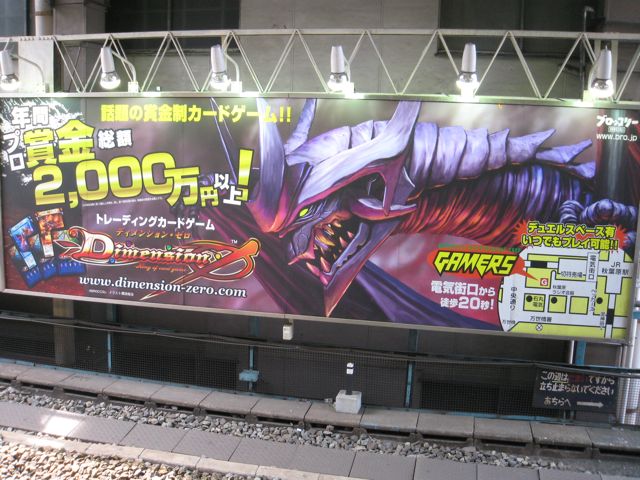
For the anime, manga, gaming crowd, this could be considered ground zero. If it comes in primary colours (or black and white) you’ll find it here.
Our first stop was Gamers, an Akiba institution. It’s famous enough that it crops up in anime and manga as a location on a regular basis. The only problem was that we were still a little early, and so only the ground floor section was open.
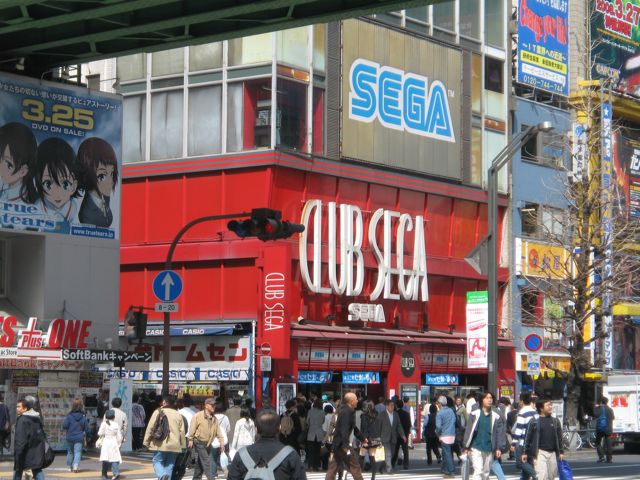
So we wandered up the street, dropping in and out of shops to see what was on offer.
This was exhausting.
It’s not that I don’t have a healthy appetite for this sort of thing, but almost all of these stores are vertical. That means you’re in for at least three, but more likely five or seven floors of up and down.
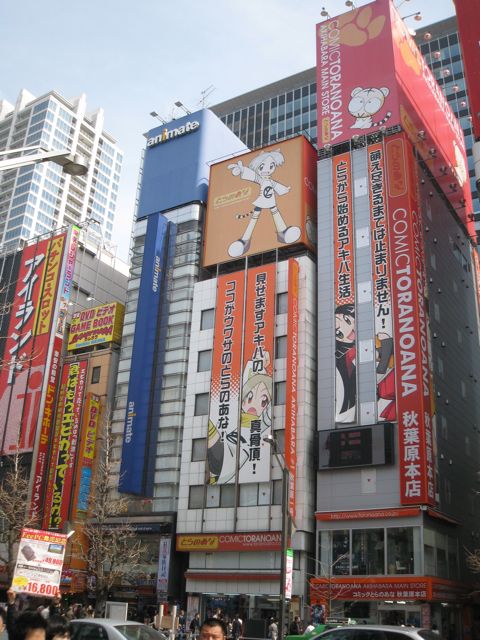
Typically, the ground floor would have the high priced new stuff. Games, DVDs (oftern imported), and some hardware. You had to climb upstairs to get to the manga and anime, both of which would often be split over a few floors based on subject matter.
If you got it wrong, you climbed the last floor to find yourself in a pink world of girls’ romance stories.
Other floors may contain only novelizations of manga, rather than the comics themselves.
And other floors would, at first glance, be anime DVD’s, but on closer inspection only be soundtracks for anime.
The DVD floors could occupy us for a considerable amount of time. Scud educated me on a number of things. One was the whole tokusatsu thing that we’d touched upon earlier in post 235. Tokusatsu deal with the whole field of special effects movies, the greater portion of which can be summed up as “people in suits”. Masked Rider and Power Rangers are two examples that I’ve spend hours watching with Scud on my lap (that was a while ago), and this genre goes way back into the 50’s, as Hiroyuki was saying, with characters like Gekko Kamen (Moonlight Mask).
There are arguments made that the form draws its inspiration from older genres, such as kabuki and bunraku. Bunraku – the puppet theatre of Japan (which I missed in Kansai) – is probably a fairer argument. Consider the great puppet shows of the 60’s – Gerry Anderson’s Thunderbirds, Captain Scarlet. If these aren’t the modern (well…half a century old is kind of modern) successors to bunraku, what is.
Plus, the Mysterions were cool.
Sadly, this lead to Team America….the less said the better……
(I’m getting that look from the family that indicates there’s a nursing home in my near future).
Anyways, the case is there for consideration. Much of the love Japan has for manga, anime, and people in colourful suits comes from a culture that’s been very open to being entertained.
Of course, the most famous Tokusatsu for me, my generation, and all Blue Oyster Cult fans has to be Godzilla. Wrestler’s in rubber suits. That’s what makes for a great fan base. Hollywood’s Godzilla was a sad thing, and it took Godzilla 2000 to exonerate the series.
Consider this bit of dialogue as passengers on the bullet train observe flames on the horizon:
“What’s that!”
“Oh, it’s just Godzilla.”
That reminds me, I still have to find the fourth Gamora movie. This is actually more of a fan production, based around the giant flying turtle. It actually tries to come to grips with the question that bothers everyone, “Why is Japan always being attacked by giant monsters?” (I won’t give it away. But see them, they’re quite good).
And, speaking of fans, there were floor after floor of dojin stuff.
I shudder.
It didn’t use to be a term to bring out such general revulsion. Really, it just refers to a group of people with a shared interest, and can be taken as just self-published (vanity press) sort of material.
But when you talk dojin to otaku, you’re talking manga fandom, and what happens when the people buying and reading this stuff get free of copyright restrictions with their favourite characters.
Some of it is kind of disturbing.
I won’t go into details. This is, after all, a food forum, and some of us are eating.
Which brings up the question…..what do you eat in Otakuland?
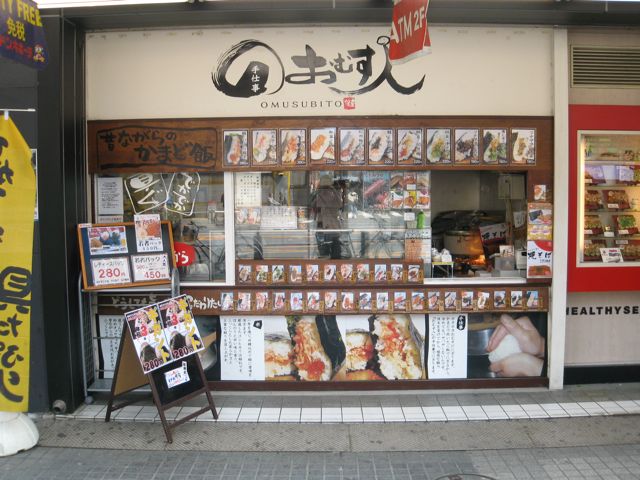
Well, I was expecting ramen shops to be in the ascendancy, but what really stood out were the onigiri places. Like sandwich shops in the West, if you want a filling, they’ve got a filling.
Scud wandered in and out of another dozen or so places, checking titles and upcoming releases, and hunting for books for some of his more literate friends back at school. After awhile I gave up on the Stairmaster routine, and contented myself with window shopping for things for Yoonhi.

This looked promising.
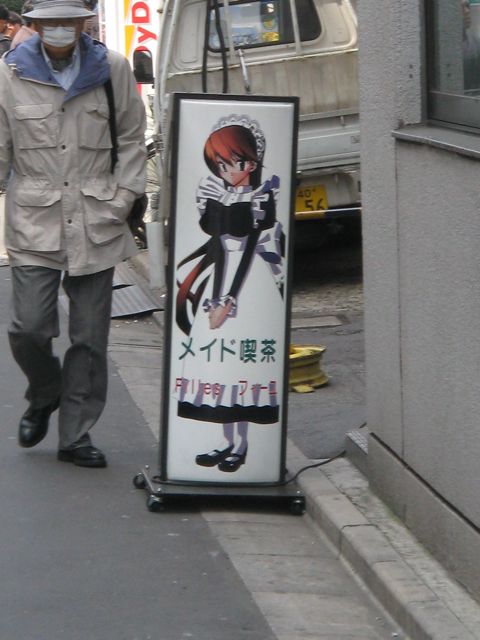
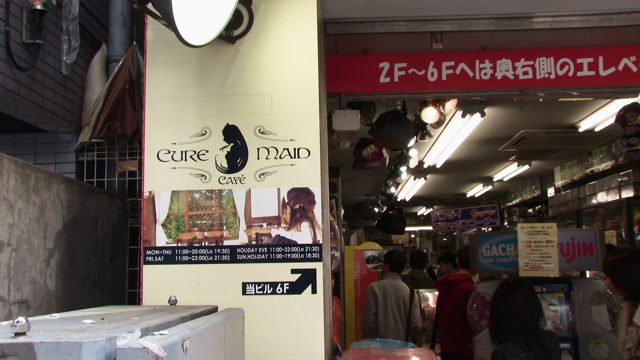
As you’d expect, besides the manga and anime, there was no shortage of maid cafes (honestly, I see nothing wrong with those). We thought we’d spotted a cosplay (costume play) café, but I was smart and had Scud hike up to the 5th floor to check it out. It turned out to be just a shop selling costumes.
I can find those on ground level.
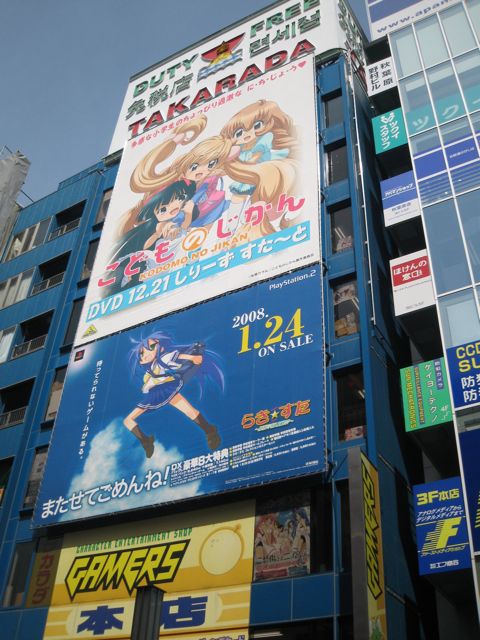
I was reading, later that evening, in Metropolis, one of the local magazines (March 21 issue) said that the Otaku were already moving on, out of Akibahara for Nakano. There’s been dual concern amongst the otaku – first, that the new, large developments are crowding out their shops and playgrounds, and second that Akiba is turning into a tourist spot, with mobs of tourists coming to gawk at them.
Are Scud and I a “mob”?
Maybe it’s the readership of the mag, but there seems to be a certain resentment in the letters section. One letter goes so far as to say “otaku are just the salarymen of tomorrow”.
Come to think of it, Salarymen Of Tomorrow would be a great name for a band.
Next: Searching For Elvis



Travelogue: Spirited Away
in Japan: Dining
Posted
I really like the part about hacking up a nematode